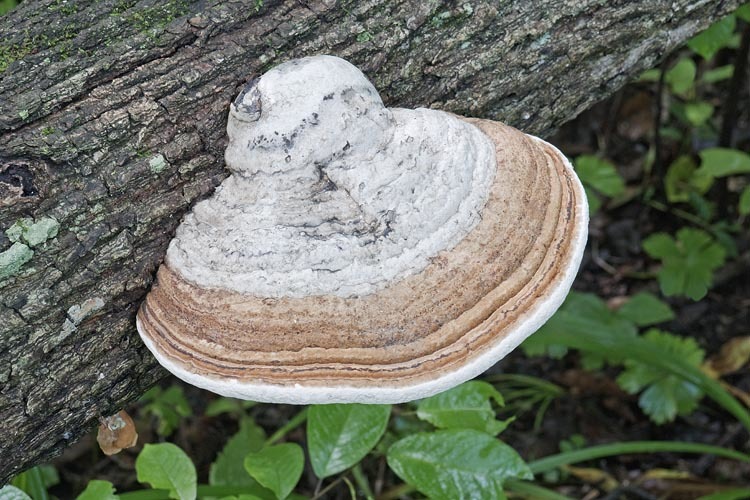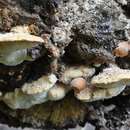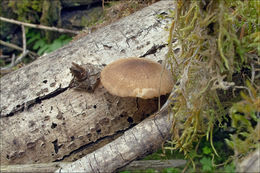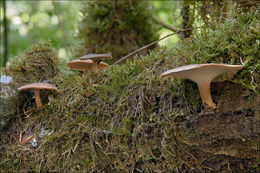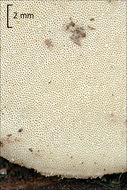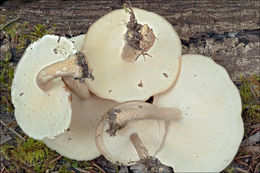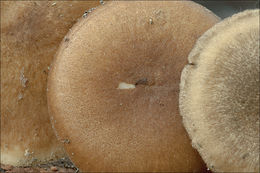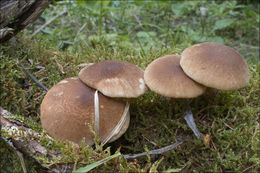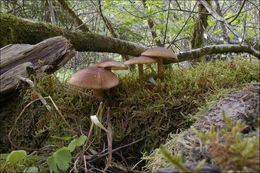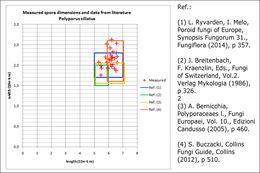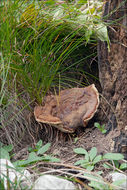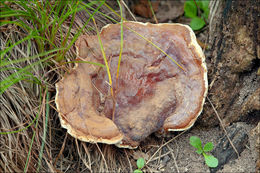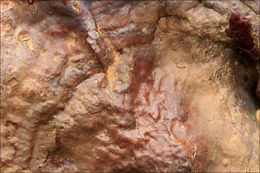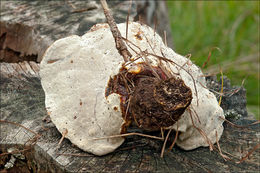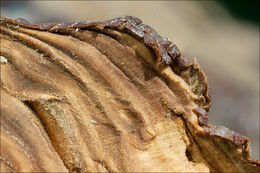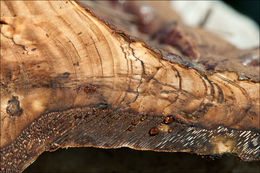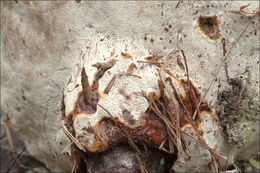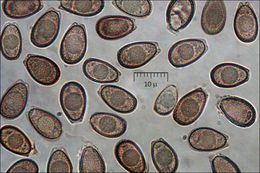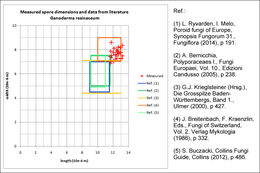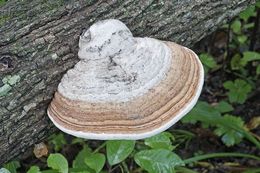-
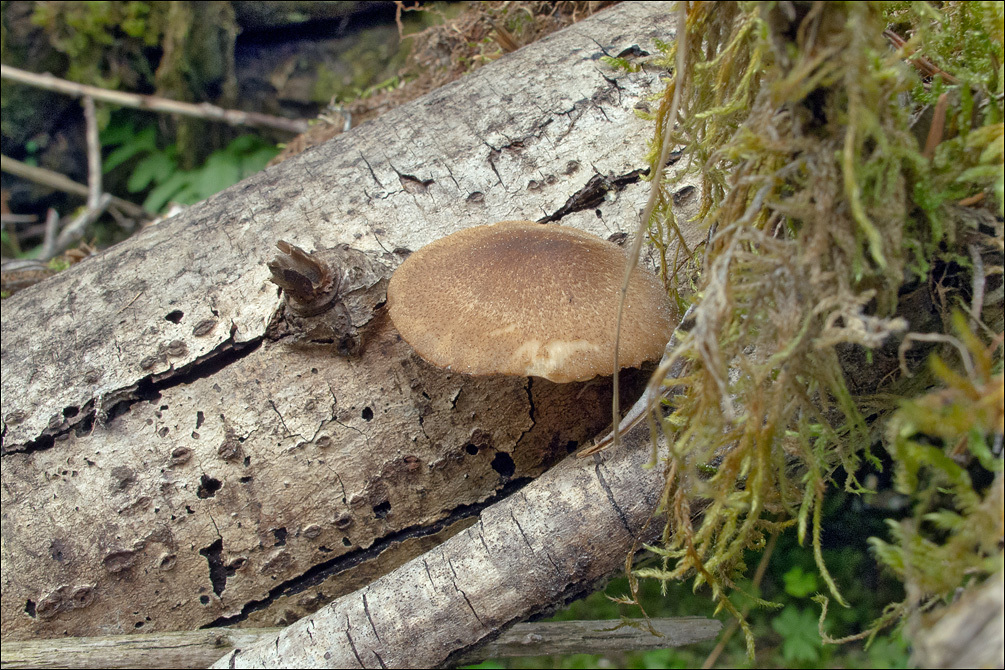
Slo.: etinasti luknjiar - syn.: Polyporus lepideus Fr. - Habitat: Young riparian forest, Picea abies and Salix eleagnos dominant trees, next to a river; flat terrain occasionally flooded during high water levels of the river, calcareous, young alluvial ground; in shade, humid ground and air; partly protected from direct rain by tree canopies; average precipitations ~ 3.000 mm/year, average temperature 7-9 deg C, elevation 530 m (1.740 feet), alpine phytogeographical region. Substratum: fallen trunk of an old Salix eleagnos mostly not in direct contact with ground, still in bark, moss covered, in the late disintegration phase. Comments: According to its species name Polyporus ciliatus should have distinctly fringed edge of the pileus. However, this was barely so with this find. Apparently this trait is not very reliable. However, very small pores, barely seen by naked eye (6 pores/mm measured) and appearance in spring clearly distinct it from very similar Polyporus brumalis. About 50 pilei found on two places. Growing solitary and in groups, occasionally two fruitbodies confluent at the base of the stipe; pilei diameter from 35 to 70 mm, pore layer thin, up to 3 mm; stipe 3 - 5 cm long, 4 - 6 mm in diameter, equal and somewhat thicker at the base; pilei surprisingly sturdy, quite hard to cut and chew; smell mild, pleasant, mushroomy; taste distinct, mushroomy, somewhat unpleasant; SP abundant, whitish-light beige, oac851. Spores smooth. Dimensions: 5,4 [6 ; 6,2] 6,8 x 1,8 [2,1 ; 2,2] 2,5 microns; Q = 2,4 [2,8 ; 2,9] 3,3; N = 30; C = 95%; Me = 6,1 x 2,1 microns; Qe = 2,9. Olympus CH20, NEA 100x/1.25, magnification 1.000 x, oil, in water, fresh material. AmScope MA500 digital camera. Herbarium: Mycotheca and lichen herbarium (LJU-Li) of Slovenian Forestry Institute, Vena pot 2, Ljubljana, Index Herbariorum LJF Ref.: (1) L. Ryvarden, I. Melo, Poroid fungi of Europe, Synopsis Fungorum 31., Fungiflora (2014), p 357. (2) J. Breitenbach, F. Kraenzlin, Eds., Fungi of Switzerland, Vol.2. Verlag Mykologia (1986), p 326. (3) A. Bernicchia, Polyporaceaes l., Fungi Europaei, Vol. 10., Edizioni Candusso (2005), p 460. (4) S. Buczacki, Collins Fungi Guide, Collins (2012), p 510. (5) G.J. Krieglsteiner (Hrsg.), Die Grosspilze Baden-Wrttembergs, Band 1, Ulmer (2000), p 609.
-
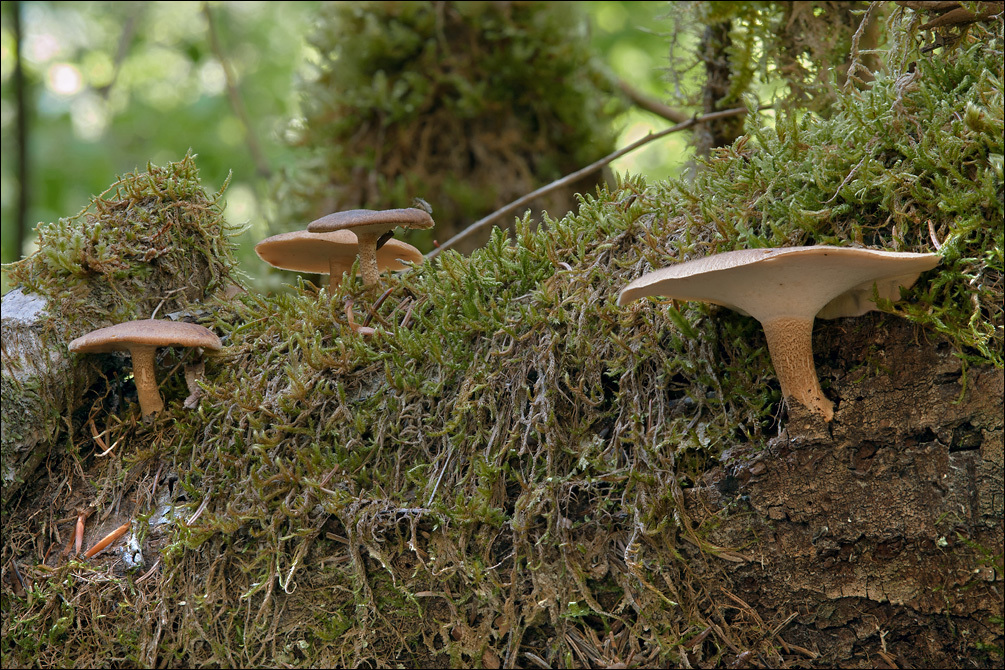
Slo.: etinasti luknjiar - syn.: Polyporus lepideus Fr. - Habitat: Young riparian forest, Picea abies and Salix eleagnos dominant trees, next to a river; flat terrain occasionally flooded during high water levels of the river, calcareous, young alluvial ground; in shade, humid ground and air; partly protected from direct rain by tree canopies; average precipitations ~ 3.000 mm/year, average temperature 7-9 deg C, elevation 530 m (1.740 feet), alpine phytogeographical region. Substratum: fallen trunk of an old Salix eleagnos mostly not in direct contact with ground, still in bark, moss covered, in the late disintegration phase. Comments: According to its species name Polyporus ciliatus should have distinctly fringed edge of the pileus. However, this was barely so with this find. Apparently this trait is not very reliable. However, very small pores, barely seen by naked eye (6 pores/mm measured) and appearance in spring clearly distinct it from very similar Polyporus brumalis. About 50 pilei found on two places. Growing solitary and in groups, occasionally two fruitbodies confluent at the base of the stipe; pilei diameter from 35 to 70 mm, pore layer thin, up to 3 mm; stipe 3 - 5 cm long, 4 - 6 mm in diameter, equal and somewhat thicker at the base; pilei surprisingly sturdy, quite hard to cut and chew; smell mild, pleasant, mushroomy; taste distinct, mushroomy, somewhat unpleasant; SP abundant, whitish-light beige, oac851. Spores smooth. Dimensions: 5,4 [6 ; 6,2] 6,8 x 1,8 [2,1 ; 2,2] 2,5 microns; Q = 2,4 [2,8 ; 2,9] 3,3; N = 30; C = 95%; Me = 6,1 x 2,1 microns; Qe = 2,9. Olympus CH20, NEA 100x/1.25, magnification 1.000 x, oil, in water, fresh material. AmScope MA500 digital camera. Herbarium: Mycotheca and lichen herbarium (LJU-Li) of Slovenian Forestry Institute, Vena pot 2, Ljubljana, Index Herbariorum LJF Ref.: (1) L. Ryvarden, I. Melo, Poroid fungi of Europe, Synopsis Fungorum 31., Fungiflora (2014), p 357. (2) J. Breitenbach, F. Kraenzlin, Eds., Fungi of Switzerland, Vol.2. Verlag Mykologia (1986), p 326. (3) A. Bernicchia, Polyporaceaes l., Fungi Europaei, Vol. 10., Edizioni Candusso (2005), p 460. (4) S. Buczacki, Collins Fungi Guide, Collins (2012), p 510. (5) G.J. Krieglsteiner (Hrsg.), Die Grosspilze Baden-Wrttembergs, Band 1, Ulmer (2000), p 609.
-
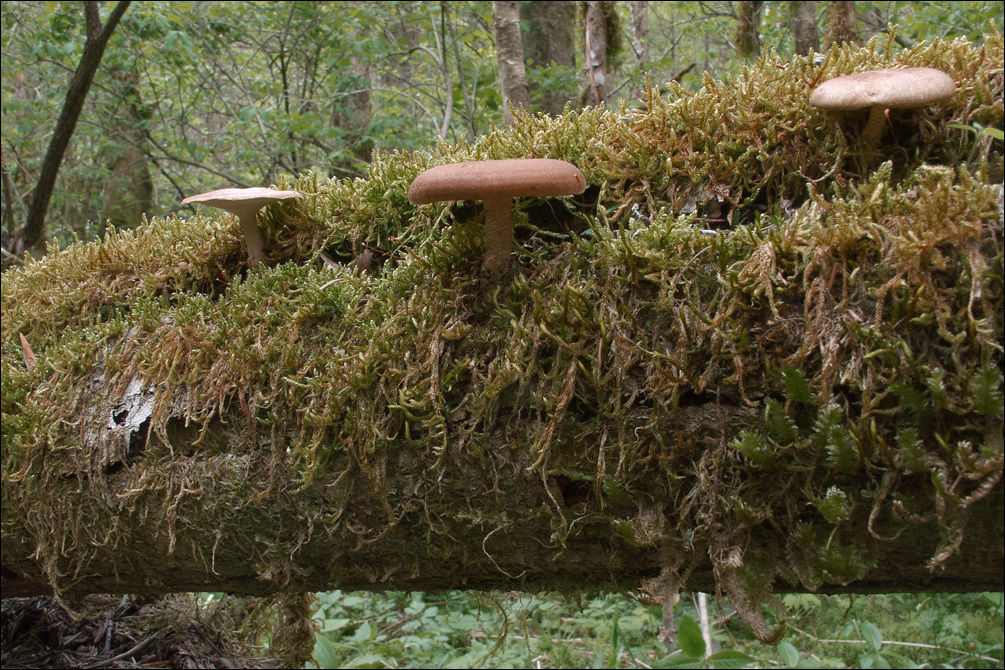
Slo.: etinasti luknjiar - syn.: Polyporus lepideus Fr. - Habitat: Young riparian forest, Picea abies and Salix eleagnos dominant trees, next to a river; flat terrain occasionally flooded during high water levels of the river, calcareous, young alluvial ground; in shade, humid ground and air; partly protected from direct rain by tree canopies; average precipitations ~ 3.000 mm/year, average temperature 7-9 deg C, elevation 530 m (1.740 feet), alpine phytogeographical region. Substratum: fallen trunk of an old Salix eleagnos mostly not in direct contact with ground, still in bark, moss covered, in the late disintegration phase. Comments: According to its species name Polyporus ciliatus should have distinctly fringed edge of the pileus. However, this was barely so with this find. Apparently this trait is not very reliable. However, very small pores, barely seen by naked eye (6 pores/mm measured) and appearance in spring clearly distinct it from very similar Polyporus brumalis. About 50 pilei found on two places. Growing solitary and in groups, occasionally two fruitbodies confluent at the base of the stipe; pilei diameter from 35 to 70 mm, pore layer thin, up to 3 mm; stipe 3 - 5 cm long, 4 - 6 mm in diameter, equal and somewhat thicker at the base; pilei surprisingly sturdy, quite hard to cut and chew; smell mild, pleasant, mushroomy; taste distinct, mushroomy, somewhat unpleasant; SP abundant, whitish-light beige, oac851. Spores smooth. Dimensions: 5,4 [6 ; 6,2] 6,8 x 1,8 [2,1 ; 2,2] 2,5 microns; Q = 2,4 [2,8 ; 2,9] 3,3; N = 30; C = 95%; Me = 6,1 x 2,1 microns; Qe = 2,9. Olympus CH20, NEA 100x/1.25, magnification 1.000 x, oil, in water, fresh material. AmScope MA500 digital camera. Herbarium: Mycotheca and lichen herbarium (LJU-Li) of Slovenian Forestry Institute, Vena pot 2, Ljubljana, Index Herbariorum LJF Ref.: (1) L. Ryvarden, I. Melo, Poroid fungi of Europe, Synopsis Fungorum 31., Fungiflora (2014), p 357. (2) J. Breitenbach, F. Kraenzlin, Eds., Fungi of Switzerland, Vol.2. Verlag Mykologia (1986), p 326. (3) A. Bernicchia, Polyporaceaes l., Fungi Europaei, Vol. 10., Edizioni Candusso (2005), p 460. (4) S. Buczacki, Collins Fungi Guide, Collins (2012), p 510. (5) G.J. Krieglsteiner (Hrsg.), Die Grosspilze Baden-Wrttembergs, Band 1, Ulmer (2000), p 609.
-
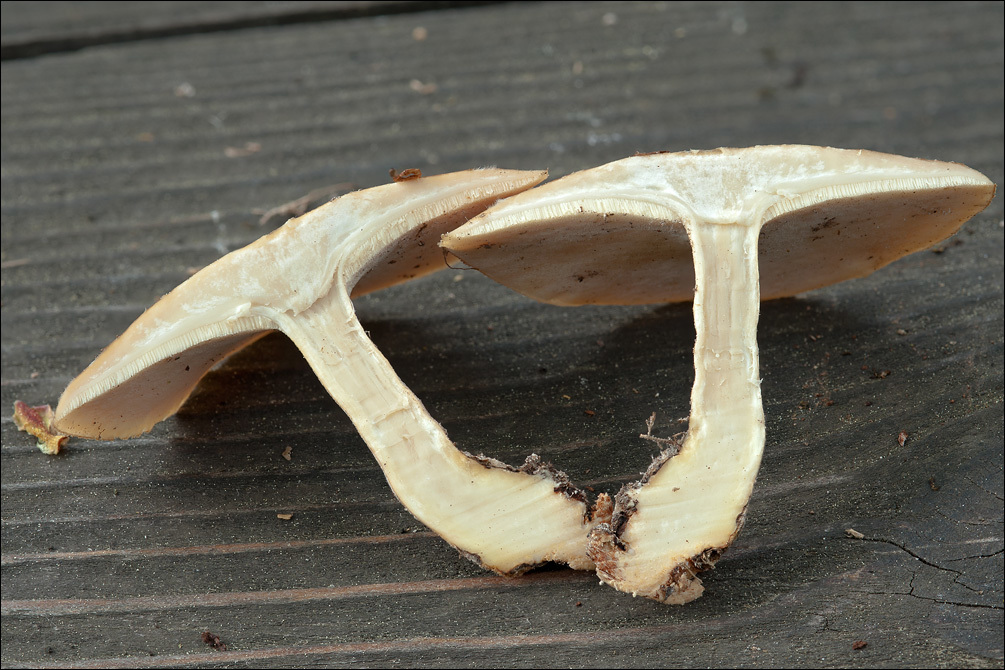
Slo.: etinasti luknjiar - syn.: Polyporus lepideus Fr. - Habitat: Young riparian forest, Picea abies and Salix eleagnos dominant trees, next to a river; flat terrain occasionally flooded during high water levels of the river, calcareous, young alluvial ground; in shade, humid ground and air; partly protected from direct rain by tree canopies; average precipitations ~ 3.000 mm/year, average temperature 7-9 deg C, elevation 530 m (1.740 feet), alpine phytogeographical region. Substratum: fallen trunk of an old Salix eleagnos mostly not in direct contact with ground, still in bark, moss covered, in the late disintegration phase. Comments: According to its species name Polyporus ciliatus should have distinctly fringed edge of the pileus. However, this was barely so with this find. Apparently this trait is not very reliable. However, very small pores, barely seen by naked eye (6 pores/mm measured) and appearance in spring clearly distinct it from very similar Polyporus brumalis. About 50 pilei found on two places. Growing solitary and in groups, occasionally two fruitbodies confluent at the base of the stipe; pilei diameter from 35 to 70 mm, pore layer thin, up to 3 mm; stipe 3 - 5 cm long, 4 - 6 mm in diameter, equal and somewhat thicker at the base; pilei surprisingly sturdy, quite hard to cut and chew; smell mild, pleasant, mushroomy; taste distinct, mushroomy, somewhat unpleasant; SP abundant, whitish-light beige, oac851. Spores smooth. Dimensions: 5,4 [6 ; 6,2] 6,8 x 1,8 [2,1 ; 2,2] 2,5 microns; Q = 2,4 [2,8 ; 2,9] 3,3; N = 30; C = 95%; Me = 6,1 x 2,1 microns; Qe = 2,9. Olympus CH20, NEA 100x/1.25, magnification 1.000 x, oil, in water, fresh material. AmScope MA500 digital camera. Herbarium: Mycotheca and lichen herbarium (LJU-Li) of Slovenian Forestry Institute, Vena pot 2, Ljubljana, Index Herbariorum LJF Ref.: (1) L. Ryvarden, I. Melo, Poroid fungi of Europe, Synopsis Fungorum 31., Fungiflora (2014), p 357. (2) J. Breitenbach, F. Kraenzlin, Eds., Fungi of Switzerland, Vol.2. Verlag Mykologia (1986), p 326. (3) A. Bernicchia, Polyporaceaes l., Fungi Europaei, Vol. 10., Edizioni Candusso (2005), p 460. (4) S. Buczacki, Collins Fungi Guide, Collins (2012), p 510. (5) G.J. Krieglsteiner (Hrsg.), Die Grosspilze Baden-Wrttembergs, Band 1, Ulmer (2000), p 609.
-
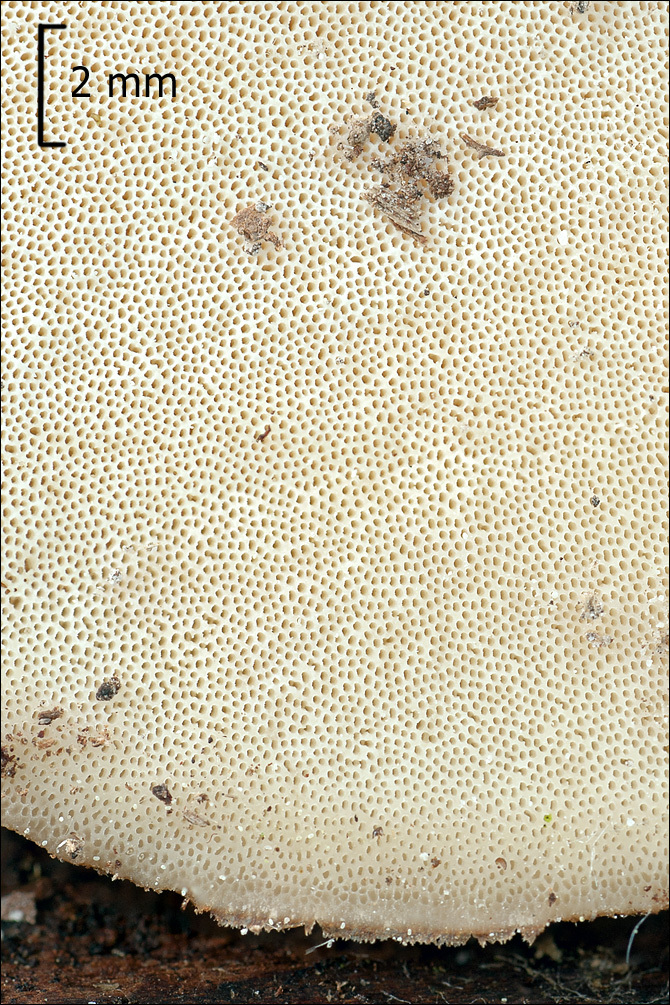
Slo.: etinasti luknjiar - syn.: Polyporus lepideus Fr. - Habitat: Young riparian forest, Picea abies and Salix eleagnos dominant trees, next to a river; flat terrain occasionally flooded during high water levels of the river, calcareous, young alluvial ground; in shade, humid ground and air; partly protected from direct rain by tree canopies; average precipitations ~ 3.000 mm/year, average temperature 7-9 deg C, elevation 530 m (1.740 feet), alpine phytogeographical region. Substratum: fallen trunk of an old Salix eleagnos mostly not in direct contact with ground, still in bark, moss covered, in the late disintegration phase. Comments: According to its species name Polyporus ciliatus should have distinctly fringed edge of the pileus. However, this was barely so with this find. Apparently this trait is not very reliable. However, very small pores, barely seen by naked eye (6 pores/mm measured) and appearance in spring clearly distinct it from very similar Polyporus brumalis. About 50 pilei found on two places. Growing solitary and in groups, occasionally two fruitbodies confluent at the base of the stipe; pilei diameter from 35 to 70 mm, pore layer thin, up to 3 mm; stipe 3 - 5 cm long, 4 - 6 mm in diameter, equal and somewhat thicker at the base; pilei surprisingly sturdy, quite hard to cut and chew; smell mild, pleasant, mushroomy; taste distinct, mushroomy, somewhat unpleasant; SP abundant, whitish-light beige, oac851. Spores smooth. Dimensions: 5,4 [6 ; 6,2] 6,8 x 1,8 [2,1 ; 2,2] 2,5 microns; Q = 2,4 [2,8 ; 2,9] 3,3; N = 30; C = 95%; Me = 6,1 x 2,1 microns; Qe = 2,9. Olympus CH20, NEA 100x/1.25, magnification 1.000 x, oil, in water, fresh material. AmScope MA500 digital camera. Herbarium: Mycotheca and lichen herbarium (LJU-Li) of Slovenian Forestry Institute, Vena pot 2, Ljubljana, Index Herbariorum LJF Ref.: (1) L. Ryvarden, I. Melo, Poroid fungi of Europe, Synopsis Fungorum 31., Fungiflora (2014), p 357. (2) J. Breitenbach, F. Kraenzlin, Eds., Fungi of Switzerland, Vol.2. Verlag Mykologia (1986), p 326. (3) A. Bernicchia, Polyporaceaes l., Fungi Europaei, Vol. 10., Edizioni Candusso (2005), p 460. (4) S. Buczacki, Collins Fungi Guide, Collins (2012), p 510. (5) G.J. Krieglsteiner (Hrsg.), Die Grosspilze Baden-Wrttembergs, Band 1, Ulmer (2000), p 609.
-
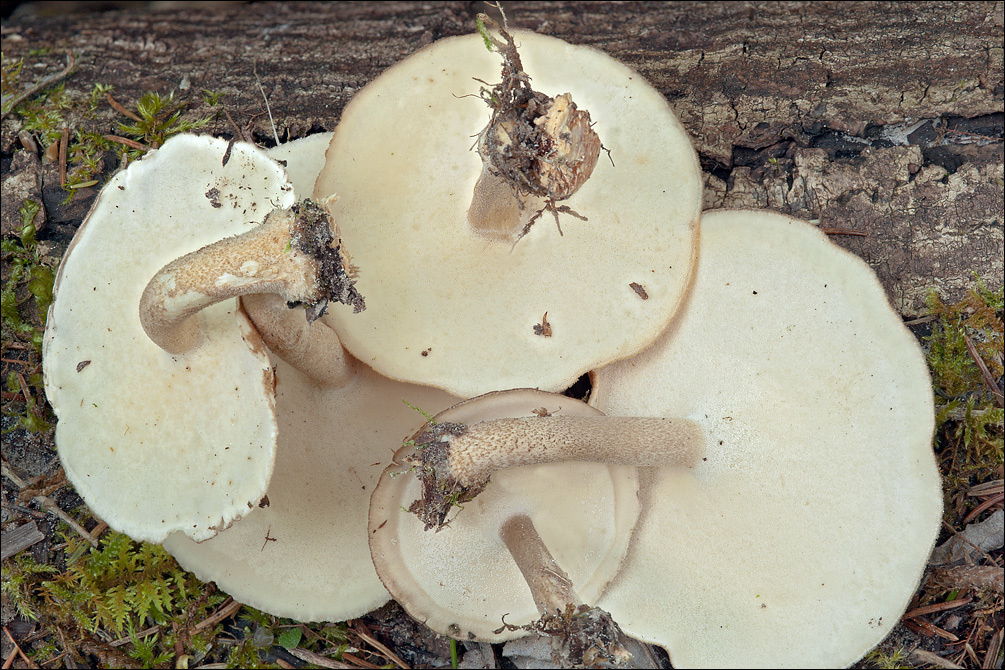
Slo.: etinasti luknjiar - syn.: Polyporus lepideus Fr. - Habitat: Young riparian forest, Picea abies and Salix eleagnos dominant trees, next to a river; flat terrain occasionally flooded during high water levels of the river, calcareous, young alluvial ground; in shade, humid ground and air; partly protected from direct rain by tree canopies; average precipitations ~ 3.000 mm/year, average temperature 7-9 deg C, elevation 530 m (1.740 feet), alpine phytogeographical region. Substratum: fallen trunk of an old Salix eleagnos mostly not in direct contact with ground, still in bark, moss covered, in the late disintegration phase. Comments: According to its species name Polyporus ciliatus should have distinctly fringed edge of the pileus. However, this was barely so with this find. Apparently this trait is not very reliable. However, very small pores, barely seen by naked eye (6 pores/mm measured) and appearance in spring clearly distinct it from very similar Polyporus brumalis. About 50 pilei found on two places. Growing solitary and in groups, occasionally two fruitbodies confluent at the base of the stipe; pilei diameter from 35 to 70 mm, pore layer thin, up to 3 mm; stipe 3 - 5 cm long, 4 - 6 mm in diameter, equal and somewhat thicker at the base; pilei surprisingly sturdy, quite hard to cut and chew; smell mild, pleasant, mushroomy; taste distinct, mushroomy, somewhat unpleasant; SP abundant, whitish-light beige, oac851. Spores smooth. Dimensions: 5,4 [6 ; 6,2] 6,8 x 1,8 [2,1 ; 2,2] 2,5 microns; Q = 2,4 [2,8 ; 2,9] 3,3; N = 30; C = 95%; Me = 6,1 x 2,1 microns; Qe = 2,9. Olympus CH20, NEA 100x/1.25, magnification 1.000 x, oil, in water, fresh material. AmScope MA500 digital camera. Herbarium: Mycotheca and lichen herbarium (LJU-Li) of Slovenian Forestry Institute, Vena pot 2, Ljubljana, Index Herbariorum LJF Ref.: (1) L. Ryvarden, I. Melo, Poroid fungi of Europe, Synopsis Fungorum 31., Fungiflora (2014), p 357. (2) J. Breitenbach, F. Kraenzlin, Eds., Fungi of Switzerland, Vol.2. Verlag Mykologia (1986), p 326. (3) A. Bernicchia, Polyporaceaes l., Fungi Europaei, Vol. 10., Edizioni Candusso (2005), p 460. (4) S. Buczacki, Collins Fungi Guide, Collins (2012), p 510. (5) G.J. Krieglsteiner (Hrsg.), Die Grosspilze Baden-Wrttembergs, Band 1, Ulmer (2000), p 609.
-
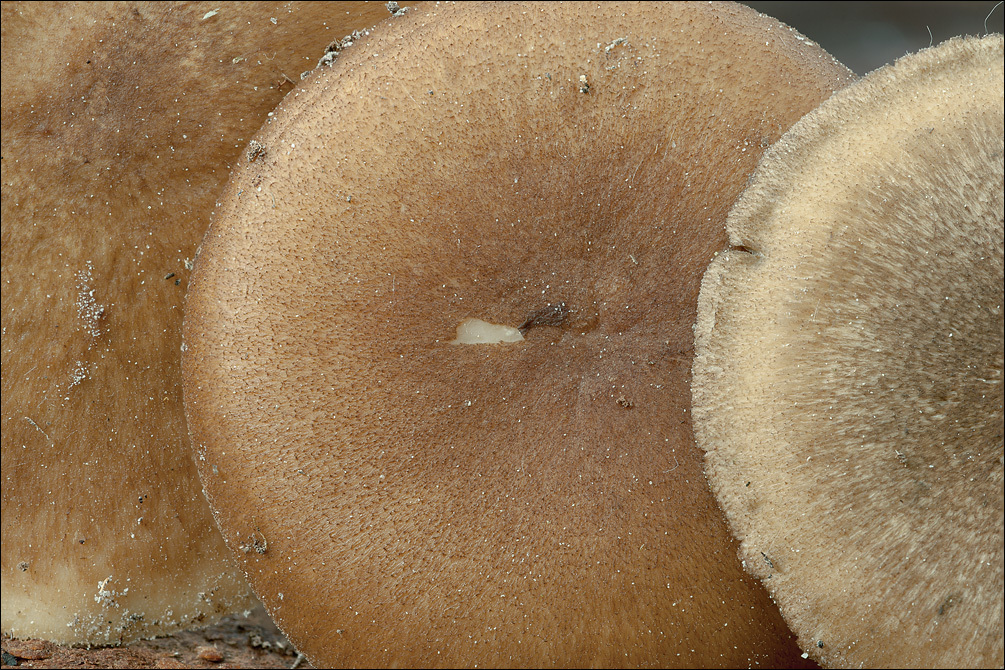
Slo.: etinasti luknjiar - syn.: Polyporus lepideus Fr. - Habitat: Young riparian forest, Picea abies and Salix eleagnos dominant trees, next to a river; flat terrain occasionally flooded during high water levels of the river, calcareous, young alluvial ground; in shade, humid ground and air; partly protected from direct rain by tree canopies; average precipitations ~ 3.000 mm/year, average temperature 7-9 deg C, elevation 530 m (1.740 feet), alpine phytogeographical region. Substratum: fallen trunk of an old Salix eleagnos mostly not in direct contact with ground, still in bark, moss covered, in the late disintegration phase. Comments: According to its species name Polyporus ciliatus should have distinctly fringed edge of the pileus. However, this was barely so with this find. Apparently this trait is not very reliable. However, very small pores, barely seen by naked eye (6 pores/mm measured) and appearance in spring clearly distinct it from very similar Polyporus brumalis. About 50 pilei found on two places. Growing solitary and in groups, occasionally two fruitbodies confluent at the base of the stipe; pilei diameter from 35 to 70 mm, pore layer thin, up to 3 mm; stipe 3 - 5 cm long, 4 - 6 mm in diameter, equal and somewhat thicker at the base; pilei surprisingly sturdy, quite hard to cut and chew; smell mild, pleasant, mushroomy; taste distinct, mushroomy, somewhat unpleasant; SP abundant, whitish-light beige, oac851. Spores smooth. Dimensions: 5,4 [6 ; 6,2] 6,8 x 1,8 [2,1 ; 2,2] 2,5 microns; Q = 2,4 [2,8 ; 2,9] 3,3; N = 30; C = 95%; Me = 6,1 x 2,1 microns; Qe = 2,9. Olympus CH20, NEA 100x/1.25, magnification 1.000 x, oil, in water, fresh material. AmScope MA500 digital camera. Herbarium: Mycotheca and lichen herbarium (LJU-Li) of Slovenian Forestry Institute, Vena pot 2, Ljubljana, Index Herbariorum LJF Ref.: (1) L. Ryvarden, I. Melo, Poroid fungi of Europe, Synopsis Fungorum 31., Fungiflora (2014), p 357. (2) J. Breitenbach, F. Kraenzlin, Eds., Fungi of Switzerland, Vol.2. Verlag Mykologia (1986), p 326. (3) A. Bernicchia, Polyporaceaes l., Fungi Europaei, Vol. 10., Edizioni Candusso (2005), p 460. (4) S. Buczacki, Collins Fungi Guide, Collins (2012), p 510. (5) G.J. Krieglsteiner (Hrsg.), Die Grosspilze Baden-Wrttembergs, Band 1, Ulmer (2000), p 609.
-
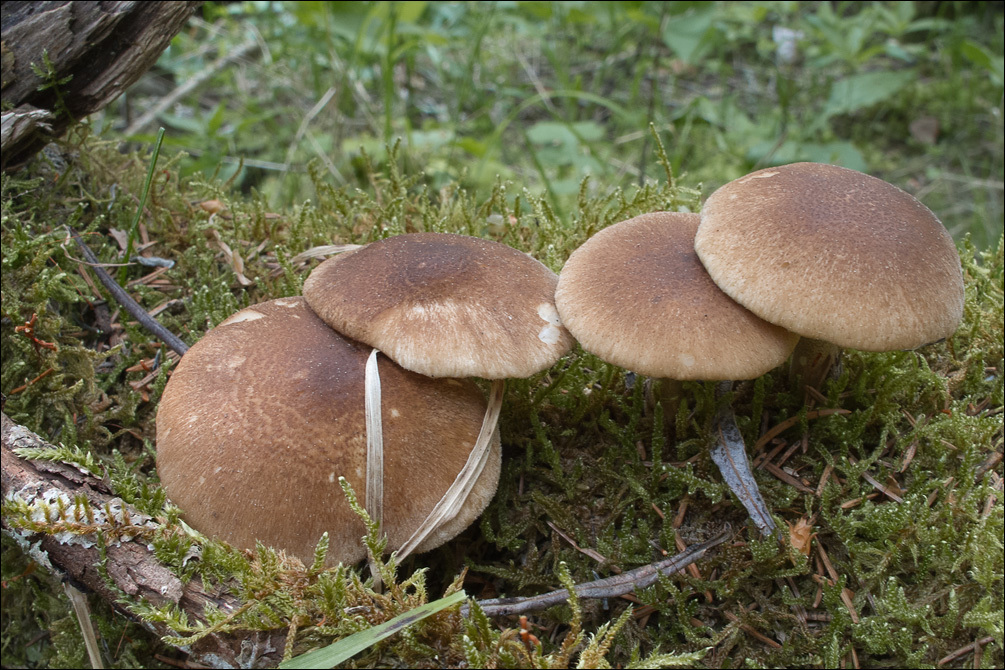
Slo.: etinasti luknjiar - syn.: Polyporus lepideus Fr. - Habitat: Young riparian forest, Picea abies and Salix eleagnos dominant trees, next to a river; flat terrain occasionally flooded during high water levels of the river, calcareous, young alluvial ground; in shade, humid ground and air; partly protected from direct rain by tree canopies; average precipitations ~ 3.000 mm/year, average temperature 7-9 deg C, elevation 530 m (1.740 feet), alpine phytogeographical region. Substratum: fallen trunk of an old Salix eleagnos mostly not in direct contact with ground, still in bark, moss covered, in the late disintegration phase. Comments: According to its species name Polyporus ciliatus should have distinctly fringed edge of the pileus. However, this was barely so with this find. Apparently this trait is not very reliable. However, very small pores, barely seen by naked eye (6 pores/mm measured) and appearance in spring clearly distinct it from very similar Polyporus brumalis. About 50 pilei found on two places. Growing solitary and in groups, occasionally two fruitbodies confluent at the base of the stipe; pilei diameter from 35 to 70 mm, pore layer thin, up to 3 mm; stipe 3 - 5 cm long, 4 - 6 mm in diameter, equal and somewhat thicker at the base; pilei surprisingly sturdy, quite hard to cut and chew; smell mild, pleasant, mushroomy; taste distinct, mushroomy, somewhat unpleasant; SP abundant, whitish-light beige, oac851. Spores smooth. Dimensions: 5,4 [6 ; 6,2] 6,8 x 1,8 [2,1 ; 2,2] 2,5 microns; Q = 2,4 [2,8 ; 2,9] 3,3; N = 30; C = 95%; Me = 6,1 x 2,1 microns; Qe = 2,9. Olympus CH20, NEA 100x/1.25, magnification 1.000 x, oil, in water, fresh material. AmScope MA500 digital camera. Herbarium: Mycotheca and lichen herbarium (LJU-Li) of Slovenian Forestry Institute, Vena pot 2, Ljubljana, Index Herbariorum LJF Ref.: (1) L. Ryvarden, I. Melo, Poroid fungi of Europe, Synopsis Fungorum 31., Fungiflora (2014), p 357. (2) J. Breitenbach, F. Kraenzlin, Eds., Fungi of Switzerland, Vol.2. Verlag Mykologia (1986), p 326. (3) A. Bernicchia, Polyporaceaes l., Fungi Europaei, Vol. 10., Edizioni Candusso (2005), p 460. (4) S. Buczacki, Collins Fungi Guide, Collins (2012), p 510. (5) G.J. Krieglsteiner (Hrsg.), Die Grosspilze Baden-Wrttembergs, Band 1, Ulmer (2000), p 609.
-
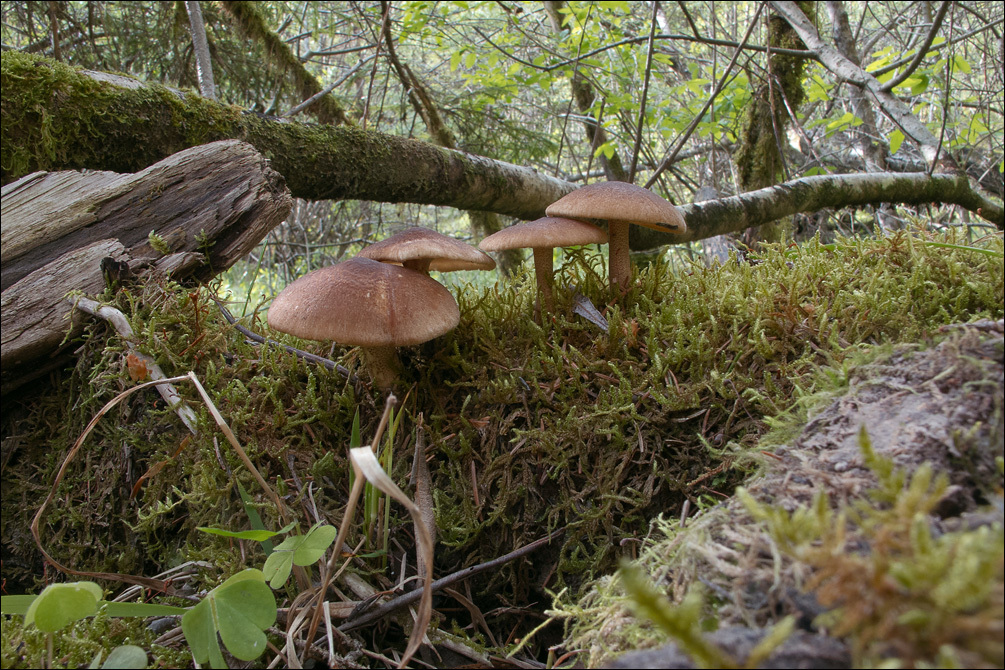
Slo.: etinasti luknjiar - syn.: Polyporus lepideus Fr. - Habitat: Young riparian forest, Picea abies and Salix eleagnos dominant trees, next to a river; flat terrain occasionally flooded during high water levels of the river, calcareous, young alluvial ground; in shade, humid ground and air; partly protected from direct rain by tree canopies; average precipitations ~ 3.000 mm/year, average temperature 7-9 deg C, elevation 530 m (1.740 feet), alpine phytogeographical region. Substratum: fallen trunk of an old Salix eleagnos mostly not in direct contact with ground, still in bark, moss covered, in the late disintegration phase. Comments: According to its species name Polyporus ciliatus should have distinctly fringed edge of the pileus. However, this was barely so with this find. Apparently this trait is not very reliable. However, very small pores, barely seen by naked eye (6 pores/mm measured) and appearance in spring clearly distinct it from very similar Polyporus brumalis. About 50 pilei found on two places. Growing solitary and in groups, occasionally two fruitbodies confluent at the base of the stipe; pilei diameter from 35 to 70 mm, pore layer thin, up to 3 mm; stipe 3 - 5 cm long, 4 - 6 mm in diameter, equal and somewhat thicker at the base; pilei surprisingly sturdy, quite hard to cut and chew; smell mild, pleasant, mushroomy; taste distinct, mushroomy, somewhat unpleasant; SP abundant, whitish-light beige, oac851. Spores smooth. Dimensions: 5,4 [6 ; 6,2] 6,8 x 1,8 [2,1 ; 2,2] 2,5 microns; Q = 2,4 [2,8 ; 2,9] 3,3; N = 30; C = 95%; Me = 6,1 x 2,1 microns; Qe = 2,9. Olympus CH20, NEA 100x/1.25, magnification 1.000 x, oil, in water, fresh material. AmScope MA500 digital camera. Herbarium: Mycotheca and lichen herbarium (LJU-Li) of Slovenian Forestry Institute, Vena pot 2, Ljubljana, Index Herbariorum LJF Ref.: (1) L. Ryvarden, I. Melo, Poroid fungi of Europe, Synopsis Fungorum 31., Fungiflora (2014), p 357. (2) J. Breitenbach, F. Kraenzlin, Eds., Fungi of Switzerland, Vol.2. Verlag Mykologia (1986), p 326. (3) A. Bernicchia, Polyporaceaes l., Fungi Europaei, Vol. 10., Edizioni Candusso (2005), p 460. (4) S. Buczacki, Collins Fungi Guide, Collins (2012), p 510. (5) G.J. Krieglsteiner (Hrsg.), Die Grosspilze Baden-Wrttembergs, Band 1, Ulmer (2000), p 609.
-
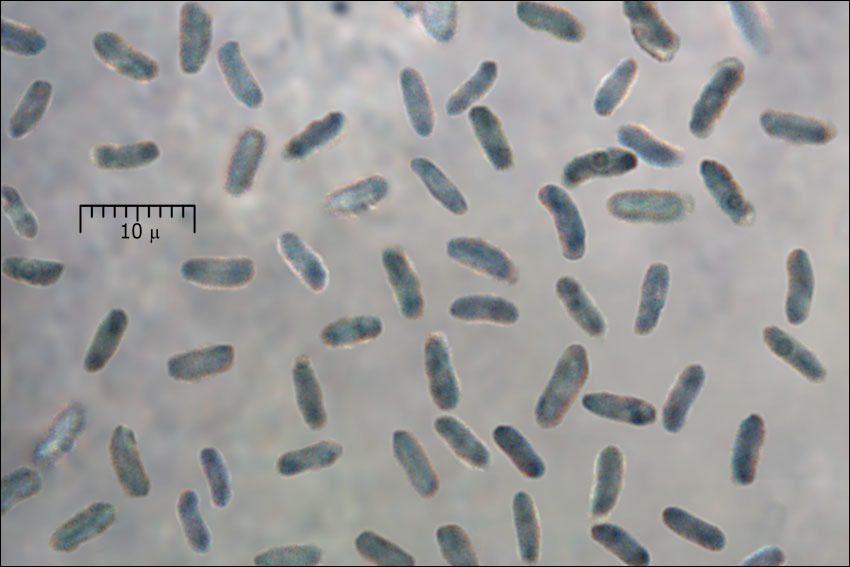
Slo.: etinasti luknjiar - syn.: Polyporus lepideus Fr. - Habitat: Young riparian forest, Picea abies and Salix eleagnos dominant trees, next to a river; flat terrain occasionally flooded during high water levels of the river, calcareous, young alluvial ground; in shade, humid ground and air; partly protected from direct rain by tree canopies; average precipitations ~ 3.000 mm/year, average temperature 7-9 deg C, elevation 530 m (1.740 feet), alpine phytogeographical region. Substratum: fallen trunk of an old Salix eleagnos mostly not in direct contact with ground, still in bark, moss covered, in the late disintegration phase. Comments: According to its species name Polyporus ciliatus should have distinctly fringed edge of the pileus. However, this was barely so with this find. Apparently this trait is not very reliable. However, very small pores, barely seen by naked eye (6 pores/mm measured) and appearance in spring clearly distinct it from very similar Polyporus brumalis. About 50 pilei found on two places. Growing solitary and in groups, occasionally two fruitbodies confluent at the base of the stipe; pilei diameter from 35 to 70 mm, pore layer thin, up to 3 mm; stipe 3 - 5 cm long, 4 - 6 mm in diameter, equal and somewhat thicker at the base; pilei surprisingly sturdy, quite hard to cut and chew; smell mild, pleasant, mushroomy; taste distinct, mushroomy, somewhat unpleasant; SP abundant, whitish-light beige, oac851. Spores smooth. Dimensions: 5,4 [6 ; 6,2] 6,8 x 1,8 [2,1 ; 2,2] 2,5 microns; Q = 2,4 [2,8 ; 2,9] 3,3; N = 30; C = 95%; Me = 6,1 x 2,1 microns; Qe = 2,9. Olympus CH20, NEA 100x/1.25, magnification 1.000 x, oil, in water, fresh material. AmScope MA500 digital camera. Herbarium: Mycotheca and lichen herbarium (LJU-Li) of Slovenian Forestry Institute, Vena pot 2, Ljubljana, Index Herbariorum LJF Ref.: (1) L. Ryvarden, I. Melo, Poroid fungi of Europe, Synopsis Fungorum 31., Fungiflora (2014), p 357. (2) J. Breitenbach, F. Kraenzlin, Eds., Fungi of Switzerland, Vol.2. Verlag Mykologia (1986), p 326. (3) A. Bernicchia, Polyporaceaes l., Fungi Europaei, Vol. 10., Edizioni Candusso (2005), p 460. (4) S. Buczacki, Collins Fungi Guide, Collins (2012), p 510. (5) G.J. Krieglsteiner (Hrsg.), Die Grosspilze Baden-Wrttembergs, Band 1, Ulmer (2000), p 609.
-

Slo.: etinasti luknjiar - syn.: Polyporus lepideus Fr. - Habitat: Young riparian forest, Picea abies and Salix eleagnos dominant trees, next to a river; flat terrain occasionally flooded during high water levels of the river, calcareous, young alluvial ground; in shade, humid ground and air; partly protected from direct rain by tree canopies; average precipitations ~ 3.000 mm/year, average temperature 7-9 deg C, elevation 530 m (1.740 feet), alpine phytogeographical region. Substratum: fallen trunk of an old Salix eleagnos mostly not in direct contact with ground, still in bark, moss covered, in the late disintegration phase. Comments: According to its species name Polyporus ciliatus should have distinctly fringed edge of the pileus. However, this was barely so with this find. Apparently this trait is not very reliable. However, very small pores, barely seen by naked eye (6 pores/mm measured) and appearance in spring clearly distinct it from very similar Polyporus brumalis. About 50 pilei found on two places. Growing solitary and in groups, occasionally two fruitbodies confluent at the base of the stipe; pilei diameter from 35 to 70 mm, pore layer thin, up to 3 mm; stipe 3 - 5 cm long, 4 - 6 mm in diameter, equal and somewhat thicker at the base; pilei surprisingly sturdy, quite hard to cut and chew; smell mild, pleasant, mushroomy; taste distinct, mushroomy, somewhat unpleasant; SP abundant, whitish-light beige, oac851. Spores smooth. Dimensions: 5,4 [6 ; 6,2] 6,8 x 1,8 [2,1 ; 2,2] 2,5 microns; Q = 2,4 [2,8 ; 2,9] 3,3; N = 30; C = 95%; Me = 6,1 x 2,1 microns; Qe = 2,9. Olympus CH20, NEA 100x/1.25, magnification 1.000 x, oil, in water, fresh material. AmScope MA500 digital camera. Herbarium: Mycotheca and lichen herbarium (LJU-Li) of Slovenian Forestry Institute, Vena pot 2, Ljubljana, Index Herbariorum LJF Ref.: (1) L. Ryvarden, I. Melo, Poroid fungi of Europe, Synopsis Fungorum 31., Fungiflora (2014), p 357. (2) J. Breitenbach, F. Kraenzlin, Eds., Fungi of Switzerland, Vol.2. Verlag Mykologia (1986), p 326. (3) A. Bernicchia, Polyporaceaes l., Fungi Europaei, Vol. 10., Edizioni Candusso (2005), p 460. (4) S. Buczacki, Collins Fungi Guide, Collins (2012), p 510. (5) G.J. Krieglsteiner (Hrsg.), Die Grosspilze Baden-Wrttembergs, Band 1, Ulmer (2000), p 609.
-

Slo.: smolena poloenka - Habitat: Alpine pasture; moderately incline mountain slope; southeast aspect; calcareous, stony, colluvial ground; shallow soil layer; full sun, dry and relatively warm place; exposed to direct rain; average precipitations ~ 3.000 mm/year, average temperature 7-9 deg C, elevation 625 m (2.050 feet), alpine phytogeographical region.Substratum: at the base of dead stump of a stand alone, cut down, mostly decorticated Ostrya carpinifolia.Comments: According to keys of genus Ganoderma published in Ryvarden (2014) and Bernicchia (2005) this find fits well to Ganoderma resinaceum. It has distinctly stipitate pileus, continuous, partly shiny and reddish-brown (not dark brown and dull as with Ganoderma applanatum and Ganoderma australe) resinous crust, which first melts and then burns with a yellow flame when heated at the tip of a knife in the flame of a match and a darker line in context just above tube layer. However, some traits not mentioned in the keys pose problems. The context color doesn't seem to correspond well to the descriptions in Ryvarden (2014) and Krieglsteiner (2000) ('pale grayish-brown') and Bernicchia (2005) ('brown, red-brown'). The find was found on dead stump of Ostrya carpinifolia (host species not listed as a possible substrate in the literature available to me) while Ganoderma resinaceum is known from live deciduous trees. Measured spores are slightly too long and too wide in average compared to most published data (the only exception is Ref.: 4). Their width fits better to similar Ganoderma pfeifferi, which is apparently always sessile and never stipitate. Measured spore dimensions actually fit perfectly to Ganoderma carnosum, which is, however, know only from conifers. Also the habitat of the find seems strange. Ganoderma resinaceum is usually found in parks, roadsides, seldom in woods. All this makes my determination uncertain to some extent.Growing solitary; pileus dimensions 10 x 8 cm; oozing reddish droplets when cut, pore layer bruising brown when handled; trama fibrous-corky and very firm, difficult to cut even with a ceramic knife; taste bitter, smell distinctive, pleasant, a kind of mushroomy; SP faint, possibly brown. Spores brown, rough, thick (double) walled. Dimensions: 11.4 [12.2 ; 12.6] 13.5 x 6.9 [7.5 ; 7.8] 8.5 microns; Q = 1.4 [1.6 ; 1.7] 1.8; N = 30; C = 95%; Me = 12.4 x 7.7 microns; Qe = 1.6. Olympus CH20, NEA 100x/1.25, magnification 1.000 x, oil, in water. AmScope MA500 digital camera.Herbarium: Mycotheca and lichen herbarium (LJU-Li) of Slovenian Forestry Institute, Vena pot 2, Ljubljana, Index Herbariorum LJFRef.:(1) L. Ryvarden, I. Melo, Poroid fungi of Europe, Synopsis Fungorum 31., Fungiflora A/S (2014), p 191. (2) A. Bernicchia, Polyporaceaes l., Fungi Europaei, Vol. 10., Edizioni Candusso (2005), p 238. (3) G.J. Krieglsteiner (Hrsg.), Die Grosspilze Baden-Wrttembergs, Band 1., Ulmer (2000), p 427. (4) J. Breitenbach, F. Kraenzlin, Eds., Fungi of Switzerland, Vol.2. Verlag Mykologia (1986), p 332. (5) S. Buczacki, Collins Fungi Guide, Collins (2012), p 486.
-
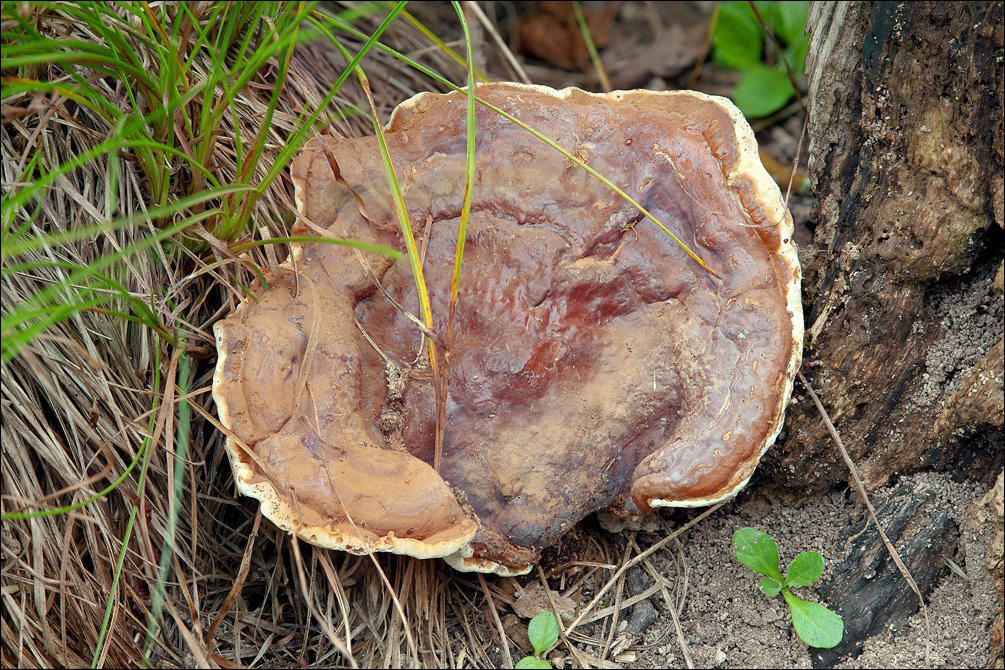
Slo.: smolena poloenka - Habitat: Alpine pasture; moderately incline mountain slope; southeast aspect; calcareous, stony, colluvial ground; shallow soil layer; full sun, dry and relatively warm place; exposed to direct rain; average precipitations ~ 3.000 mm/year, average temperature 7-9 deg C, elevation 625 m (2.050 feet), alpine phytogeographical region. Substratum: at the base of dead stump of a stand alone, cut down, mostly decorticated Ostrya carpinifolia. Comments: According to keys of genus Ganoderma published in Ryvarden (2014) and Bernicchia (2005) this find fits well to Ganoderma resinaceum. It has distinctly stipitate pileus, continuous, partly shiny and reddish-brown (not dark brown and dull as with Ganoderma applanatum and Ganoderma australe) resinous crust, which first melts and then burns with a yellow flame when heated at the tip of a knife in the flame of a match and a darker line in context just above tube layer. However, some traits not mentioned in the keys pose problems. The context color doesn't seem to correspond well to the descriptions in Ryvarden (2014) and Krieglsteiner (2000) ('pale grayish-brown') and Bernicchia (2005) ('brown, red-brown'). The find was found on dead stump of Ostrya carpinifolia (host species not listed as a possible substrate in the literature available to me) while Ganoderma resinaceum is known from live deciduous trees. Measured spores are slightly too long and too wide in average compared to most published data (the only exception is Ref.: 4). Their width fits better to similar Ganoderma pfeifferi, which is apparently always sessile and never stipitate. Measured spore dimensions actually fit perfectly to Ganoderma carnosum, which is, however, know only from conifers. Also the habitat of the find seems strange. Ganoderma resinaceum is usually found in parks, roadsides, seldom in woods. All this makes my determination uncertain to some extent. Growing solitary; pileus dimensions 10 x 8 cm; oozing reddish droplets when cut, pore layer bruising brown when handled; trama fibrous-corky and very firm, difficult to cut even with a ceramic knife; taste bitter, smell distinctive, pleasant, a kind of mushroomy; SP faint, possibly brown. Spores brown, rough, thick (double) walled. Dimensions: 11.4 [12.2 ; 12.6] 13.5 x 6.9 [7.5 ; 7.8] 8.5 microns; Q = 1.4 [1.6 ; 1.7] 1.8; N = 30; C = 95%; Me = 12.4 x 7.7 microns; Qe = 1.6. Olympus CH20, NEA 100x/1.25, magnification 1.000 x, oil, in water. AmScope MA500 digital camera. Herbarium: Mycotheca and lichen herbarium (LJU-Li) of Slovenian Forestry Institute, Vena pot 2, Ljubljana, Index Herbariorum LJF Ref.: (1) L. Ryvarden, I. Melo, Poroid fungi of Europe, Synopsis Fungorum 31., Fungiflora A/S (2014), p 191. (2) A. Bernicchia, Polyporaceaes l., Fungi Europaei, Vol. 10., Edizioni Candusso (2005), p 238. (3) G.J. Krieglsteiner (Hrsg.), Die Grosspilze Baden-Wrttembergs, Band 1., Ulmer (2000), p 427. (4) J. Breitenbach, F. Kraenzlin, Eds., Fungi of Switzerland, Vol.2. Verlag Mykologia (1986), p 332. (5) S. Buczacki, Collins Fungi Guide, Collins (2012), p 486.
-

Slo.: smolena poloenka - Habitat: Alpine pasture; moderately incline mountain slope; southeast aspect; calcareous, stony, colluvial ground; shallow soil layer; full sun, dry and relatively warm place; exposed to direct rain; average precipitations ~ 3.000 mm/year, average temperature 7-9 deg C, elevation 625 m (2.050 feet), alpine phytogeographical region. Substratum: at the base of dead stump of a stand alone, cut down, mostly decorticated Ostrya carpinifolia. Comments: According to keys of genus Ganoderma published in Ryvarden (2014) and Bernicchia (2005) this find fits well to Ganoderma resinaceum. It has distinctly stipitate pileus, continuous, partly shiny and reddish-brown (not dark brown and dull as with Ganoderma applanatum and Ganoderma australe) resinous crust, which first melts and then burns with a yellow flame when heated at the tip of a knife in the flame of a match and a darker line in context just above tube layer. However, some traits not mentioned in the keys pose problems. The context color doesn't seem to correspond well to the descriptions in Ryvarden (2014) and Krieglsteiner (2000) ('pale grayish-brown') and Bernicchia (2005) ('brown, red-brown'). The find was found on dead stump of Ostrya carpinifolia (host species not listed as a possible substrate in the literature available to me) while Ganoderma resinaceum is known from live deciduous trees. Measured spores are slightly too long and too wide in average compared to most published data (the only exception is Ref.: 4). Their width fits better to similar Ganoderma pfeifferi, which is apparently always sessile and never stipitate. Measured spore dimensions actually fit perfectly to Ganoderma carnosum, which is, however, know only from conifers. Also the habitat of the find seems strange. Ganoderma resinaceum is usually found in parks, roadsides, seldom in woods. All this makes my determination uncertain to some extent. Growing solitary; pileus dimensions 10 x 8 cm; oozing reddish droplets when cut, pore layer bruising brown when handled; trama fibrous-corky and very firm, difficult to cut even with a ceramic knife; taste bitter, smell distinctive, pleasant, a kind of mushroomy; SP faint, possibly brown. Spores brown, rough, thick (double) walled. Dimensions: 11.4 [12.2 ; 12.6] 13.5 x 6.9 [7.5 ; 7.8] 8.5 microns; Q = 1.4 [1.6 ; 1.7] 1.8; N = 30; C = 95%; Me = 12.4 x 7.7 microns; Qe = 1.6. Olympus CH20, NEA 100x/1.25, magnification 1.000 x, oil, in water. AmScope MA500 digital camera. Herbarium: Mycotheca and lichen herbarium (LJU-Li) of Slovenian Forestry Institute, Vena pot 2, Ljubljana, Index Herbariorum LJF Ref.: (1) L. Ryvarden, I. Melo, Poroid fungi of Europe, Synopsis Fungorum 31., Fungiflora A/S (2014), p 191. (2) A. Bernicchia, Polyporaceaes l., Fungi Europaei, Vol. 10., Edizioni Candusso (2005), p 238. (3) G.J. Krieglsteiner (Hrsg.), Die Grosspilze Baden-Wrttembergs, Band 1., Ulmer (2000), p 427. (4) J. Breitenbach, F. Kraenzlin, Eds., Fungi of Switzerland, Vol.2. Verlag Mykologia (1986), p 332. (5) S. Buczacki, Collins Fungi Guide, Collins (2012), p 486.
-

Slo.: smolena poloenka - Habitat: Alpine pasture; moderately incline mountain slope; southeast aspect; calcareous, stony, colluvial ground; shallow soil layer; full sun, dry and relatively warm place; exposed to direct rain; average precipitations ~ 3.000 mm/year, average temperature 7-9 deg C, elevation 625 m (2.050 feet), alpine phytogeographical region. Substratum: at the base of dead stump of a stand alone, cut down, mostly decorticated Ostrya carpinifolia. Comments: According to keys of genus Ganoderma published in Ryvarden (2014) and Bernicchia (2005) this find fits well to Ganoderma resinaceum. It has distinctly stipitate pileus, continuous, partly shiny and reddish-brown (not dark brown and dull as with Ganoderma applanatum and Ganoderma australe) resinous crust, which first melts and then burns with a yellow flame when heated at the tip of a knife in the flame of a match and a darker line in context just above tube layer. However, some traits not mentioned in the keys pose problems. The context color doesn't seem to correspond well to the descriptions in Ryvarden (2014) and Krieglsteiner (2000) ('pale grayish-brown') and Bernicchia (2005) ('brown, red-brown'). The find was found on dead stump of Ostrya carpinifolia (host species not listed as a possible substrate in the literature available to me) while Ganoderma resinaceum is known from live deciduous trees. Measured spores are slightly too long and too wide in average compared to most published data (the only exception is Ref.: 4). Their width fits better to similar Ganoderma pfeifferi, which is apparently always sessile and never stipitate. Measured spore dimensions actually fit perfectly to Ganoderma carnosum, which is, however, know only from conifers. Also the habitat of the find seems strange. Ganoderma resinaceum is usually found in parks, roadsides, seldom in woods. All this makes my determination uncertain to some extent. Growing solitary; pileus dimensions 10 x 8 cm; oozing reddish droplets when cut, pore layer bruising brown when handled; trama fibrous-corky and very firm, difficult to cut even with a ceramic knife; taste bitter, smell distinctive, pleasant, a kind of mushroomy; SP faint, possibly brown. Spores brown, rough, thick (double) walled. Dimensions: 11.4 [12.2 ; 12.6] 13.5 x 6.9 [7.5 ; 7.8] 8.5 microns; Q = 1.4 [1.6 ; 1.7] 1.8; N = 30; C = 95%; Me = 12.4 x 7.7 microns; Qe = 1.6. Olympus CH20, NEA 100x/1.25, magnification 1.000 x, oil, in water. AmScope MA500 digital camera. Herbarium: Mycotheca and lichen herbarium (LJU-Li) of Slovenian Forestry Institute, Vena pot 2, Ljubljana, Index Herbariorum LJF Ref.: (1) L. Ryvarden, I. Melo, Poroid fungi of Europe, Synopsis Fungorum 31., Fungiflora A/S (2014), p 191. (2) A. Bernicchia, Polyporaceaes l., Fungi Europaei, Vol. 10., Edizioni Candusso (2005), p 238. (3) G.J. Krieglsteiner (Hrsg.), Die Grosspilze Baden-Wrttembergs, Band 1., Ulmer (2000), p 427. (4) J. Breitenbach, F. Kraenzlin, Eds., Fungi of Switzerland, Vol.2. Verlag Mykologia (1986), p 332. (5) S. Buczacki, Collins Fungi Guide, Collins (2012), p 486.
-
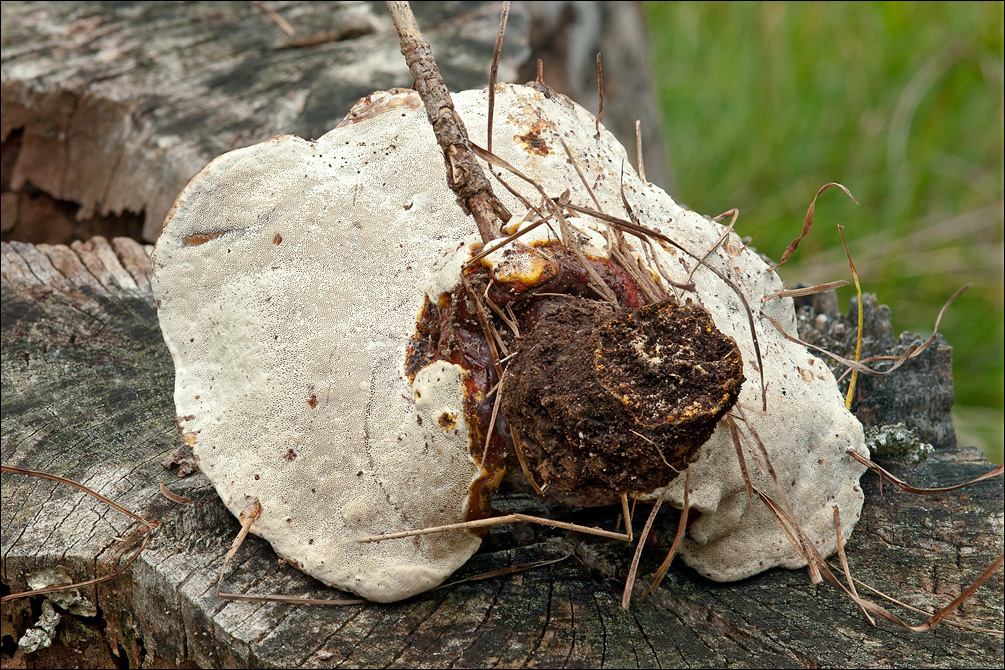
Slo.: smolena poloenka - Habitat: Alpine pasture; moderately incline mountain slope; southeast aspect; calcareous, stony, colluvial ground; shallow soil layer; full sun, dry and relatively warm place; exposed to direct rain; average precipitations ~ 3.000 mm/year, average temperature 7-9 deg C, elevation 625 m (2.050 feet), alpine phytogeographical region. Substratum: at the base of dead stump of a stand alone, cut down, mostly decorticated Ostrya carpinifolia. Comments: According to keys of genus Ganoderma published in Ryvarden (2014) and Bernicchia (2005) this find fits well to Ganoderma resinaceum. It has distinctly stipitate pileus, continuous, partly shiny and reddish-brown (not dark brown and dull as with Ganoderma applanatum and Ganoderma australe) resinous crust, which first melts and then burns with a yellow flame when heated at the tip of a knife in the flame of a match and a darker line in context just above tube layer. However, some traits not mentioned in the keys pose problems. The context color doesn't seem to correspond well to the descriptions in Ryvarden (2014) and Krieglsteiner (2000) ('pale grayish-brown') and Bernicchia (2005) ('brown, red-brown'). The find was found on dead stump of Ostrya carpinifolia (host species not listed as a possible substrate in the literature available to me) while Ganoderma resinaceum is known from live deciduous trees. Measured spores are slightly too long and too wide in average compared to most published data (the only exception is Ref.: 4). Their width fits better to similar Ganoderma pfeifferi, which is apparently always sessile and never stipitate. Measured spore dimensions actually fit perfectly to Ganoderma carnosum, which is, however, know only from conifers. Also the habitat of the find seems strange. Ganoderma resinaceum is usually found in parks, roadsides, seldom in woods. All this makes my determination uncertain to some extent. Growing solitary; pileus dimensions 10 x 8 cm; oozing reddish droplets when cut, pore layer bruising brown when handled; trama fibrous-corky and very firm, difficult to cut even with a ceramic knife; taste bitter, smell distinctive, pleasant, a kind of mushroomy; SP faint, possibly brown. Spores brown, rough, thick (double) walled. Dimensions: 11.4 [12.2 ; 12.6] 13.5 x 6.9 [7.5 ; 7.8] 8.5 microns; Q = 1.4 [1.6 ; 1.7] 1.8; N = 30; C = 95%; Me = 12.4 x 7.7 microns; Qe = 1.6. Olympus CH20, NEA 100x/1.25, magnification 1.000 x, oil, in water. AmScope MA500 digital camera. Herbarium: Mycotheca and lichen herbarium (LJU-Li) of Slovenian Forestry Institute, Vena pot 2, Ljubljana, Index Herbariorum LJF Ref.: (1) L. Ryvarden, I. Melo, Poroid fungi of Europe, Synopsis Fungorum 31., Fungiflora A/S (2014), p 191. (2) A. Bernicchia, Polyporaceaes l., Fungi Europaei, Vol. 10., Edizioni Candusso (2005), p 238. (3) G.J. Krieglsteiner (Hrsg.), Die Grosspilze Baden-Wrttembergs, Band 1., Ulmer (2000), p 427. (4) J. Breitenbach, F. Kraenzlin, Eds., Fungi of Switzerland, Vol.2. Verlag Mykologia (1986), p 332. (5) S. Buczacki, Collins Fungi Guide, Collins (2012), p 486.
-
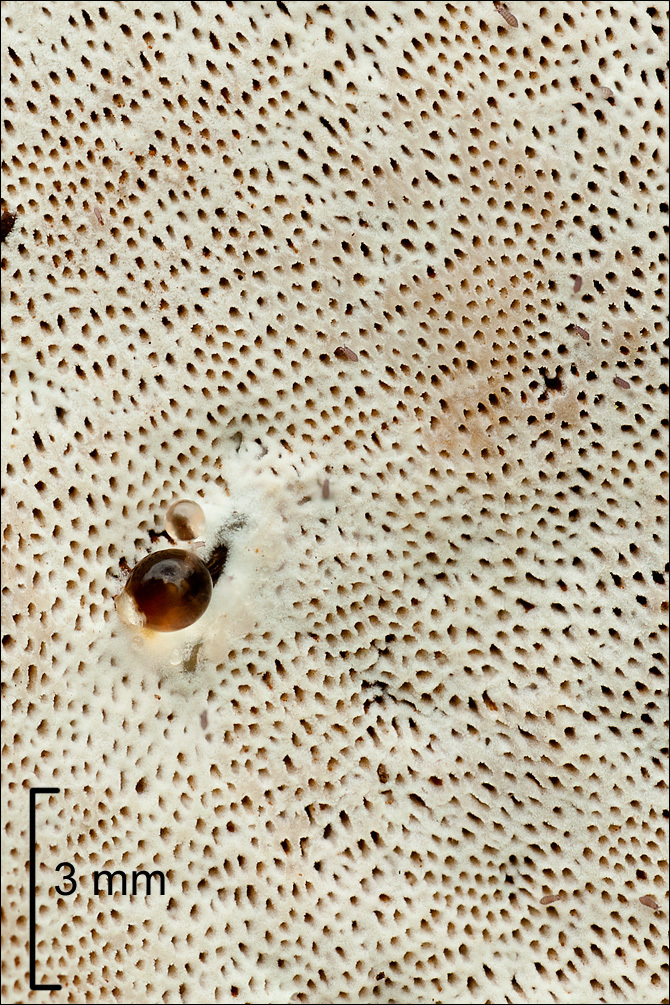
Slo.: smolena poloenka - Habitat: Alpine pasture; moderately incline mountain slope; southeast aspect; calcareous, stony, colluvial ground; shallow soil layer; full sun, dry and relatively warm place; exposed to direct rain; average precipitations ~ 3.000 mm/year, average temperature 7-9 deg C, elevation 625 m (2.050 feet), alpine phytogeographical region. Substratum: at the base of dead stump of a stand alone, cut down, mostly decorticated Ostrya carpinifolia. Comments: According to keys of genus Ganoderma published in Ryvarden (2014) and Bernicchia (2005) this find fits well to Ganoderma resinaceum. It has distinctly stipitate pileus, continuous, partly shiny and reddish-brown (not dark brown and dull as with Ganoderma applanatum and Ganoderma australe) resinous crust, which first melts and then burns with a yellow flame when heated at the tip of a knife in the flame of a match and a darker line in context just above tube layer. However, some traits not mentioned in the keys pose problems. The context color doesn't seem to correspond well to the descriptions in Ryvarden (2014) and Krieglsteiner (2000) ('pale grayish-brown') and Bernicchia (2005) ('brown, red-brown'). The find was found on dead stump of Ostrya carpinifolia (host species not listed as a possible substrate in the literature available to me) while Ganoderma resinaceum is known from live deciduous trees. Measured spores are slightly too long and too wide in average compared to most published data (the only exception is Ref.: 4). Their width fits better to similar Ganoderma pfeifferi, which is apparently always sessile and never stipitate. Measured spore dimensions actually fit perfectly to Ganoderma carnosum, which is, however, know only from conifers. Also the habitat of the find seems strange. Ganoderma resinaceum is usually found in parks, roadsides, seldom in woods. All this makes my determination uncertain to some extent. Growing solitary; pileus dimensions 10 x 8 cm; oozing reddish droplets when cut, pore layer bruising brown when handled; trama fibrous-corky and very firm, difficult to cut even with a ceramic knife; taste bitter, smell distinctive, pleasant, a kind of mushroomy; SP faint, possibly brown. Spores brown, rough, thick (double) walled. Dimensions: 11.4 [12.2 ; 12.6] 13.5 x 6.9 [7.5 ; 7.8] 8.5 microns; Q = 1.4 [1.6 ; 1.7] 1.8; N = 30; C = 95%; Me = 12.4 x 7.7 microns; Qe = 1.6. Olympus CH20, NEA 100x/1.25, magnification 1.000 x, oil, in water. AmScope MA500 digital camera. Herbarium: Mycotheca and lichen herbarium (LJU-Li) of Slovenian Forestry Institute, Vena pot 2, Ljubljana, Index Herbariorum LJF Ref.: (1) L. Ryvarden, I. Melo, Poroid fungi of Europe, Synopsis Fungorum 31., Fungiflora A/S (2014), p 191. (2) A. Bernicchia, Polyporaceaes l., Fungi Europaei, Vol. 10., Edizioni Candusso (2005), p 238. (3) G.J. Krieglsteiner (Hrsg.), Die Grosspilze Baden-Wrttembergs, Band 1., Ulmer (2000), p 427. (4) J. Breitenbach, F. Kraenzlin, Eds., Fungi of Switzerland, Vol.2. Verlag Mykologia (1986), p 332. (5) S. Buczacki, Collins Fungi Guide, Collins (2012), p 486.
-
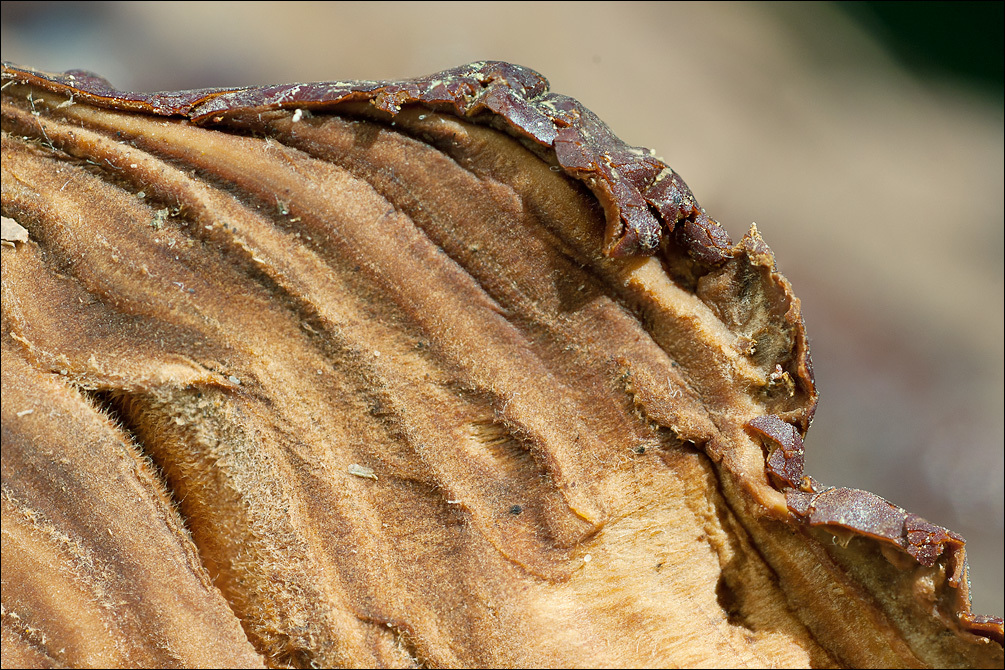
Slo.: smolena poloenka - Habitat: Alpine pasture; moderately incline mountain slope; southeast aspect; calcareous, stony, colluvial ground; shallow soil layer; full sun, dry and relatively warm place; exposed to direct rain; average precipitations ~ 3.000 mm/year, average temperature 7-9 deg C, elevation 625 m (2.050 feet), alpine phytogeographical region. Substratum: at the base of dead stump of a stand alone, cut down, mostly decorticated Ostrya carpinifolia. Comments: According to keys of genus Ganoderma published in Ryvarden (2014) and Bernicchia (2005) this find fits well to Ganoderma resinaceum. It has distinctly stipitate pileus, continuous, partly shiny and reddish-brown (not dark brown and dull as with Ganoderma applanatum and Ganoderma australe) resinous crust, which first melts and then burns with a yellow flame when heated at the tip of a knife in the flame of a match and a darker line in context just above tube layer. However, some traits not mentioned in the keys pose problems. The context color doesn't seem to correspond well to the descriptions in Ryvarden (2014) and Krieglsteiner (2000) ('pale grayish-brown') and Bernicchia (2005) ('brown, red-brown'). The find was found on dead stump of Ostrya carpinifolia (host species not listed as a possible substrate in the literature available to me) while Ganoderma resinaceum is known from live deciduous trees. Measured spores are slightly too long and too wide in average compared to most published data (the only exception is Ref.: 4). Their width fits better to similar Ganoderma pfeifferi, which is apparently always sessile and never stipitate. Measured spore dimensions actually fit perfectly to Ganoderma carnosum, which is, however, know only from conifers. Also the habitat of the find seems strange. Ganoderma resinaceum is usually found in parks, roadsides, seldom in woods. All this makes my determination uncertain to some extent. Growing solitary; pileus dimensions 10 x 8 cm; oozing reddish droplets when cut, pore layer bruising brown when handled; trama fibrous-corky and very firm, difficult to cut even with a ceramic knife; taste bitter, smell distinctive, pleasant, a kind of mushroomy; SP faint, possibly brown. Spores brown, rough, thick (double) walled. Dimensions: 11.4 [12.2 ; 12.6] 13.5 x 6.9 [7.5 ; 7.8] 8.5 microns; Q = 1.4 [1.6 ; 1.7] 1.8; N = 30; C = 95%; Me = 12.4 x 7.7 microns; Qe = 1.6. Olympus CH20, NEA 100x/1.25, magnification 1.000 x, oil, in water. AmScope MA500 digital camera. Herbarium: Mycotheca and lichen herbarium (LJU-Li) of Slovenian Forestry Institute, Vena pot 2, Ljubljana, Index Herbariorum LJF Ref.: (1) L. Ryvarden, I. Melo, Poroid fungi of Europe, Synopsis Fungorum 31., Fungiflora A/S (2014), p 191. (2) A. Bernicchia, Polyporaceaes l., Fungi Europaei, Vol. 10., Edizioni Candusso (2005), p 238. (3) G.J. Krieglsteiner (Hrsg.), Die Grosspilze Baden-Wrttembergs, Band 1., Ulmer (2000), p 427. (4) J. Breitenbach, F. Kraenzlin, Eds., Fungi of Switzerland, Vol.2. Verlag Mykologia (1986), p 332. (5) S. Buczacki, Collins Fungi Guide, Collins (2012), p 486.
-
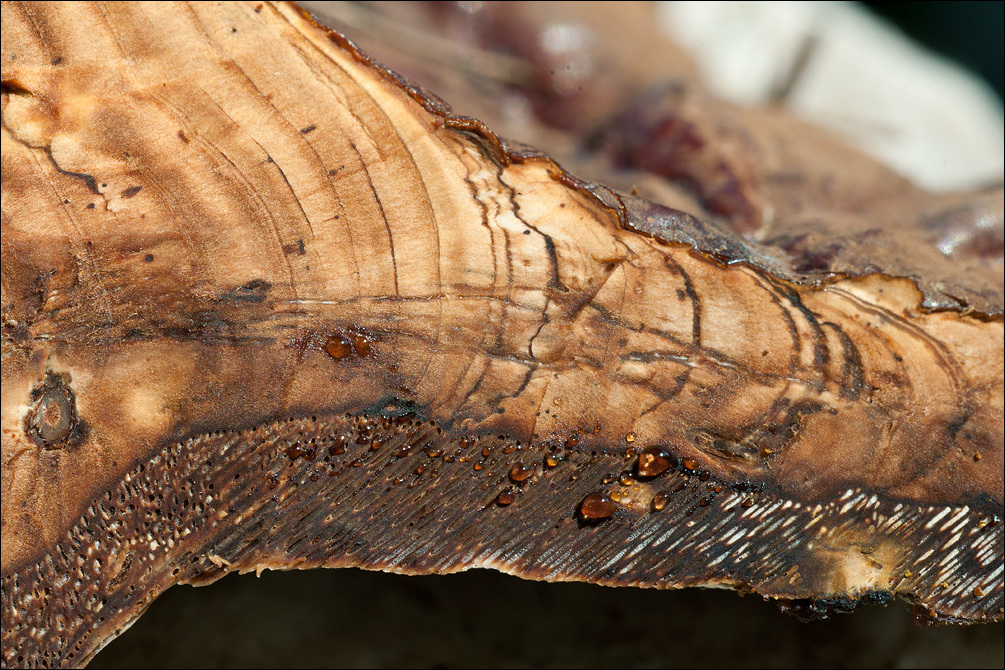
Slo.: smolena poloenka - Habitat: Alpine pasture; moderately incline mountain slope; southeast aspect; calcareous, stony, colluvial ground; shallow soil layer; full sun, dry and relatively warm place; exposed to direct rain; average precipitations ~ 3.000 mm/year, average temperature 7-9 deg C, elevation 625 m (2.050 feet), alpine phytogeographical region. Substratum: at the base of dead stump of a stand alone, cut down, mostly decorticated Ostrya carpinifolia. Comments: According to keys of genus Ganoderma published in Ryvarden (2014) and Bernicchia (2005) this find fits well to Ganoderma resinaceum. It has distinctly stipitate pileus, continuous, partly shiny and reddish-brown (not dark brown and dull as with Ganoderma applanatum and Ganoderma australe) resinous crust, which first melts and then burns with a yellow flame when heated at the tip of a knife in the flame of a match and a darker line in context just above tube layer. However, some traits not mentioned in the keys pose problems. The context color doesn't seem to correspond well to the descriptions in Ryvarden (2014) and Krieglsteiner (2000) ('pale grayish-brown') and Bernicchia (2005) ('brown, red-brown'). The find was found on dead stump of Ostrya carpinifolia (host species not listed as a possible substrate in the literature available to me) while Ganoderma resinaceum is known from live deciduous trees. Measured spores are slightly too long and too wide in average compared to most published data (the only exception is Ref.: 4). Their width fits better to similar Ganoderma pfeifferi, which is apparently always sessile and never stipitate. Measured spore dimensions actually fit perfectly to Ganoderma carnosum, which is, however, know only from conifers. Also the habitat of the find seems strange. Ganoderma resinaceum is usually found in parks, roadsides, seldom in woods. All this makes my determination uncertain to some extent. Growing solitary; pileus dimensions 10 x 8 cm; oozing reddish droplets when cut, pore layer bruising brown when handled; trama fibrous-corky and very firm, difficult to cut even with a ceramic knife; taste bitter, smell distinctive, pleasant, a kind of mushroomy; SP faint, possibly brown. Spores brown, rough, thick (double) walled. Dimensions: 11.4 [12.2 ; 12.6] 13.5 x 6.9 [7.5 ; 7.8] 8.5 microns; Q = 1.4 [1.6 ; 1.7] 1.8; N = 30; C = 95%; Me = 12.4 x 7.7 microns; Qe = 1.6. Olympus CH20, NEA 100x/1.25, magnification 1.000 x, oil, in water. AmScope MA500 digital camera. Herbarium: Mycotheca and lichen herbarium (LJU-Li) of Slovenian Forestry Institute, Vena pot 2, Ljubljana, Index Herbariorum LJF Ref.: (1) L. Ryvarden, I. Melo, Poroid fungi of Europe, Synopsis Fungorum 31., Fungiflora A/S (2014), p 191. (2) A. Bernicchia, Polyporaceaes l., Fungi Europaei, Vol. 10., Edizioni Candusso (2005), p 238. (3) G.J. Krieglsteiner (Hrsg.), Die Grosspilze Baden-Wrttembergs, Band 1., Ulmer (2000), p 427. (4) J. Breitenbach, F. Kraenzlin, Eds., Fungi of Switzerland, Vol.2. Verlag Mykologia (1986), p 332. (5) S. Buczacki, Collins Fungi Guide, Collins (2012), p 486.
-
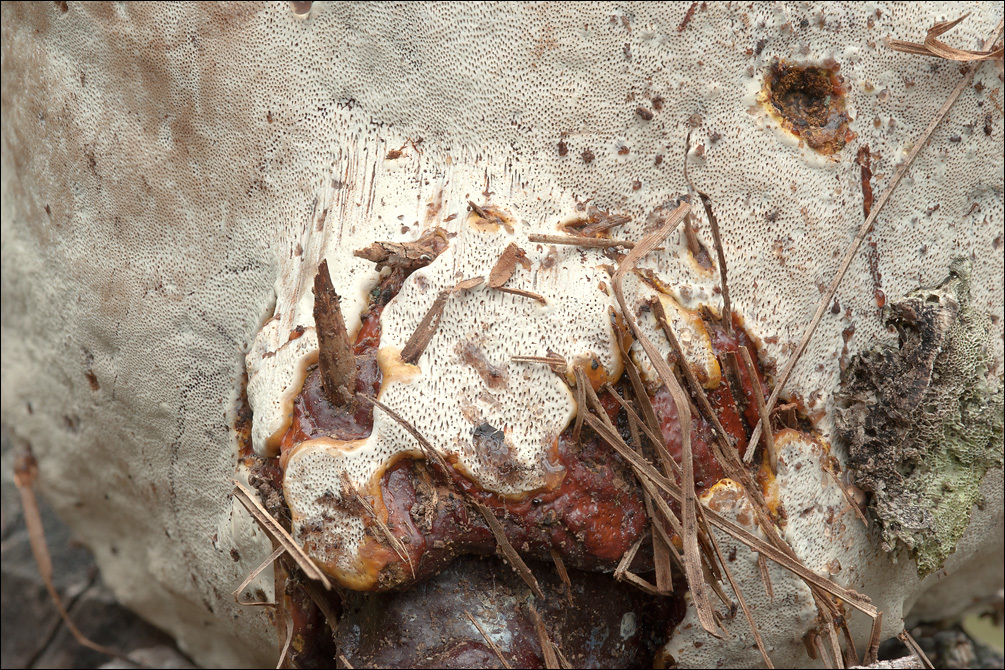
Slo.: smolena poloenka - Habitat: Alpine pasture; moderately incline mountain slope; southeast aspect; calcareous, stony, colluvial ground; shallow soil layer; full sun, dry and relatively warm place; exposed to direct rain; average precipitations ~ 3.000 mm/year, average temperature 7-9 deg C, elevation 625 m (2.050 feet), alpine phytogeographical region. Substratum: at the base of dead stump of a stand alone, cut down, mostly decorticated Ostrya carpinifolia. Comments: According to keys of genus Ganoderma published in Ryvarden (2014) and Bernicchia (2005) this find fits well to Ganoderma resinaceum. It has distinctly stipitate pileus, continuous, partly shiny and reddish-brown (not dark brown and dull as with Ganoderma applanatum and Ganoderma australe) resinous crust, which first melts and then burns with a yellow flame when heated at the tip of a knife in the flame of a match and a darker line in context just above tube layer. However, some traits not mentioned in the keys pose problems. The context color doesn't seem to correspond well to the descriptions in Ryvarden (2014) and Krieglsteiner (2000) ('pale grayish-brown') and Bernicchia (2005) ('brown, red-brown'). The find was found on dead stump of Ostrya carpinifolia (host species not listed as a possible substrate in the literature available to me) while Ganoderma resinaceum is known from live deciduous trees. Measured spores are slightly too long and too wide in average compared to most published data (the only exception is Ref.: 4). Their width fits better to similar Ganoderma pfeifferi, which is apparently always sessile and never stipitate. Measured spore dimensions actually fit perfectly to Ganoderma carnosum, which is, however, know only from conifers. Also the habitat of the find seems strange. Ganoderma resinaceum is usually found in parks, roadsides, seldom in woods. All this makes my determination uncertain to some extent. Growing solitary; pileus dimensions 10 x 8 cm; oozing reddish droplets when cut, pore layer bruising brown when handled; trama fibrous-corky and very firm, difficult to cut even with a ceramic knife; taste bitter, smell distinctive, pleasant, a kind of mushroomy; SP faint, possibly brown. Spores brown, rough, thick (double) walled. Dimensions: 11.4 [12.2 ; 12.6] 13.5 x 6.9 [7.5 ; 7.8] 8.5 microns; Q = 1.4 [1.6 ; 1.7] 1.8; N = 30; C = 95%; Me = 12.4 x 7.7 microns; Qe = 1.6. Olympus CH20, NEA 100x/1.25, magnification 1.000 x, oil, in water. AmScope MA500 digital camera. Herbarium: Mycotheca and lichen herbarium (LJU-Li) of Slovenian Forestry Institute, Vena pot 2, Ljubljana, Index Herbariorum LJF Ref.: (1) L. Ryvarden, I. Melo, Poroid fungi of Europe, Synopsis Fungorum 31., Fungiflora A/S (2014), p 191. (2) A. Bernicchia, Polyporaceaes l., Fungi Europaei, Vol. 10., Edizioni Candusso (2005), p 238. (3) G.J. Krieglsteiner (Hrsg.), Die Grosspilze Baden-Wrttembergs, Band 1., Ulmer (2000), p 427. (4) J. Breitenbach, F. Kraenzlin, Eds., Fungi of Switzerland, Vol.2. Verlag Mykologia (1986), p 332. (5) S. Buczacki, Collins Fungi Guide, Collins (2012), p 486.
-
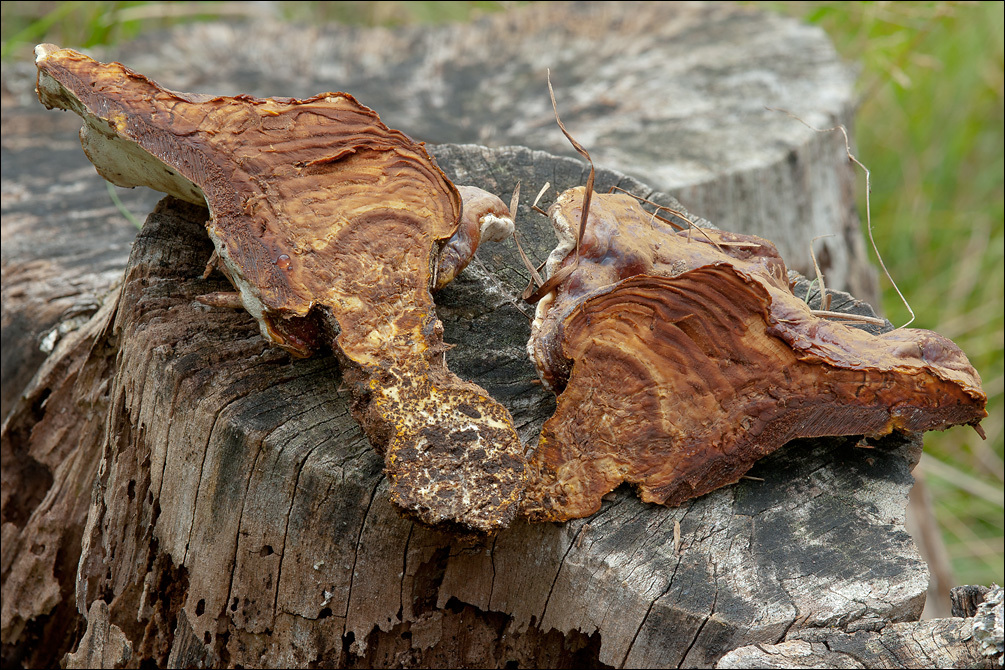
Slo.: smolena poloenka - Habitat: Alpine pasture; moderately incline mountain slope; southeast aspect; calcareous, stony, colluvial ground; shallow soil layer; full sun, dry and relatively warm place; exposed to direct rain; average precipitations ~ 3.000 mm/year, average temperature 7-9 deg C, elevation 625 m (2.050 feet), alpine phytogeographical region. Substratum: at the base of dead stump of a stand alone, cut down, mostly decorticated Ostrya carpinifolia. Comments: According to keys of genus Ganoderma published in Ryvarden (2014) and Bernicchia (2005) this find fits well to Ganoderma resinaceum. It has distinctly stipitate pileus, continuous, partly shiny and reddish-brown (not dark brown and dull as with Ganoderma applanatum and Ganoderma australe) resinous crust, which first melts and then burns with a yellow flame when heated at the tip of a knife in the flame of a match and a darker line in context just above tube layer. However, some traits not mentioned in the keys pose problems. The context color doesn't seem to correspond well to the descriptions in Ryvarden (2014) and Krieglsteiner (2000) ('pale grayish-brown') and Bernicchia (2005) ('brown, red-brown'). The find was found on dead stump of Ostrya carpinifolia (host species not listed as a possible substrate in the literature available to me) while Ganoderma resinaceum is known from live deciduous trees. Measured spores are slightly too long and too wide in average compared to most published data (the only exception is Ref.: 4). Their width fits better to similar Ganoderma pfeifferi, which is apparently always sessile and never stipitate. Measured spore dimensions actually fit perfectly to Ganoderma carnosum, which is, however, know only from conifers. Also the habitat of the find seems strange. Ganoderma resinaceum is usually found in parks, roadsides, seldom in woods. All this makes my determination uncertain to some extent. Growing solitary; pileus dimensions 10 x 8 cm; oozing reddish droplets when cut, pore layer bruising brown when handled; trama fibrous-corky and very firm, difficult to cut even with a ceramic knife; taste bitter, smell distinctive, pleasant, a kind of mushroomy; SP faint, possibly brown. Spores brown, rough, thick (double) walled. Dimensions: 11.4 [12.2 ; 12.6] 13.5 x 6.9 [7.5 ; 7.8] 8.5 microns; Q = 1.4 [1.6 ; 1.7] 1.8; N = 30; C = 95%; Me = 12.4 x 7.7 microns; Qe = 1.6. Olympus CH20, NEA 100x/1.25, magnification 1.000 x, oil, in water. AmScope MA500 digital camera. Herbarium: Mycotheca and lichen herbarium (LJU-Li) of Slovenian Forestry Institute, Vena pot 2, Ljubljana, Index Herbariorum LJF Ref.: (1) L. Ryvarden, I. Melo, Poroid fungi of Europe, Synopsis Fungorum 31., Fungiflora A/S (2014), p 191. (2) A. Bernicchia, Polyporaceaes l., Fungi Europaei, Vol. 10., Edizioni Candusso (2005), p 238. (3) G.J. Krieglsteiner (Hrsg.), Die Grosspilze Baden-Wrttembergs, Band 1., Ulmer (2000), p 427. (4) J. Breitenbach, F. Kraenzlin, Eds., Fungi of Switzerland, Vol.2. Verlag Mykologia (1986), p 332. (5) S. Buczacki, Collins Fungi Guide, Collins (2012), p 486.
-

Slo.: smolena poloenka - Habitat: Alpine pasture; moderately incline mountain slope; southeast aspect; calcareous, stony, colluvial ground; shallow soil layer; full sun, dry and relatively warm place; exposed to direct rain; average precipitations ~ 3.000 mm/year, average temperature 7-9 deg C, elevation 625 m (2.050 feet), alpine phytogeographical region. Substratum: at the base of dead stump of a stand alone, cut down, mostly decorticated Ostrya carpinifolia. Comments: According to keys of genus Ganoderma published in Ryvarden (2014) and Bernicchia (2005) this find fits well to Ganoderma resinaceum. It has distinctly stipitate pileus, continuous, partly shiny and reddish-brown (not dark brown and dull as with Ganoderma applanatum and Ganoderma australe) resinous crust, which first melts and then burns with a yellow flame when heated at the tip of a knife in the flame of a match and a darker line in context just above tube layer. However, some traits not mentioned in the keys pose problems. The context color doesn't seem to correspond well to the descriptions in Ryvarden (2014) and Krieglsteiner (2000) ('pale grayish-brown') and Bernicchia (2005) ('brown, red-brown'). The find was found on dead stump of Ostrya carpinifolia (host species not listed as a possible substrate in the literature available to me) while Ganoderma resinaceum is known from live deciduous trees. Measured spores are slightly too long and too wide in average compared to most published data (the only exception is Ref.: 4). Their width fits better to similar Ganoderma pfeifferi, which is apparently always sessile and never stipitate. Measured spore dimensions actually fit perfectly to Ganoderma carnosum, which is, however, know only from conifers. Also the habitat of the find seems strange. Ganoderma resinaceum is usually found in parks, roadsides, seldom in woods. All this makes my determination uncertain to some extent. Growing solitary; pileus dimensions 10 x 8 cm; oozing reddish droplets when cut, pore layer bruising brown when handled; trama fibrous-corky and very firm, difficult to cut even with a ceramic knife; taste bitter, smell distinctive, pleasant, a kind of mushroomy; SP faint, possibly brown. Spores brown, rough, thick (double) walled. Dimensions: 11.4 [12.2 ; 12.6] 13.5 x 6.9 [7.5 ; 7.8] 8.5 microns; Q = 1.4 [1.6 ; 1.7] 1.8; N = 30; C = 95%; Me = 12.4 x 7.7 microns; Qe = 1.6. Olympus CH20, NEA 100x/1.25, magnification 1.000 x, oil, in water. AmScope MA500 digital camera. Herbarium: Mycotheca and lichen herbarium (LJU-Li) of Slovenian Forestry Institute, Vena pot 2, Ljubljana, Index Herbariorum LJF Ref.: (1) L. Ryvarden, I. Melo, Poroid fungi of Europe, Synopsis Fungorum 31., Fungiflora A/S (2014), p 191. (2) A. Bernicchia, Polyporaceaes l., Fungi Europaei, Vol. 10., Edizioni Candusso (2005), p 238. (3) G.J. Krieglsteiner (Hrsg.), Die Grosspilze Baden-Wrttembergs, Band 1., Ulmer (2000), p 427. (4) J. Breitenbach, F. Kraenzlin, Eds., Fungi of Switzerland, Vol.2. Verlag Mykologia (1986), p 332. (5) S. Buczacki, Collins Fungi Guide, Collins (2012), p 486.
-

Slo.: smolena poloenka - Habitat: Alpine pasture; moderately incline mountain slope; southeast aspect; calcareous, stony, colluvial ground; shallow soil layer; full sun, dry and relatively warm place; exposed to direct rain; average precipitations ~ 3.000 mm/year, average temperature 7-9 deg C, elevation 625 m (2.050 feet), alpine phytogeographical region. Substratum: at the base of dead stump of a stand alone, cut down, mostly decorticated Ostrya carpinifolia. Comments: According to keys of genus Ganoderma published in Ryvarden (2014) and Bernicchia (2005) this find fits well to Ganoderma resinaceum. It has distinctly stipitate pileus, continuous, partly shiny and reddish-brown (not dark brown and dull as with Ganoderma applanatum and Ganoderma australe) resinous crust, which first melts and then burns with a yellow flame when heated at the tip of a knife in the flame of a match and a darker line in context just above tube layer. However, some traits not mentioned in the keys pose problems. The context color doesn't seem to correspond well to the descriptions in Ryvarden (2014) and Krieglsteiner (2000) ('pale grayish-brown') and Bernicchia (2005) ('brown, red-brown'). The find was found on dead stump of Ostrya carpinifolia (host species not listed as a possible substrate in the literature available to me) while Ganoderma resinaceum is known from live deciduous trees. Measured spores are slightly too long and too wide in average compared to most published data (the only exception is Ref.: 4). Their width fits better to similar Ganoderma pfeifferi, which is apparently always sessile and never stipitate. Measured spore dimensions actually fit perfectly to Ganoderma carnosum, which is, however, know only from conifers. Also the habitat of the find seems strange. Ganoderma resinaceum is usually found in parks, roadsides, seldom in woods. All this makes my determination uncertain to some extent. Growing solitary; pileus dimensions 10 x 8 cm; oozing reddish droplets when cut, pore layer bruising brown when handled; trama fibrous-corky and very firm, difficult to cut even with a ceramic knife; taste bitter, smell distinctive, pleasant, a kind of mushroomy; SP faint, possibly brown. Spores brown, rough, thick (double) walled. Dimensions: 11.4 [12.2 ; 12.6] 13.5 x 6.9 [7.5 ; 7.8] 8.5 microns; Q = 1.4 [1.6 ; 1.7] 1.8; N = 30; C = 95%; Me = 12.4 x 7.7 microns; Qe = 1.6. Olympus CH20, NEA 100x/1.25, magnification 1.000 x, oil, in water. AmScope MA500 digital camera. Herbarium: Mycotheca and lichen herbarium (LJU-Li) of Slovenian Forestry Institute, Vena pot 2, Ljubljana, Index Herbariorum LJF Ref.: (1) L. Ryvarden, I. Melo, Poroid fungi of Europe, Synopsis Fungorum 31., Fungiflora A/S (2014), p 191. (2) A. Bernicchia, Polyporaceaes l., Fungi Europaei, Vol. 10., Edizioni Candusso (2005), p 238. (3) G.J. Krieglsteiner (Hrsg.), Die Grosspilze Baden-Wrttembergs, Band 1., Ulmer (2000), p 427. (4) J. Breitenbach, F. Kraenzlin, Eds., Fungi of Switzerland, Vol.2. Verlag Mykologia (1986), p 332. (5) S. Buczacki, Collins Fungi Guide, Collins (2012), p 486.
-
























